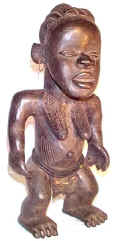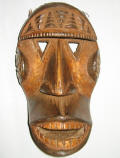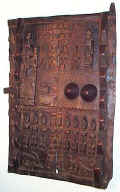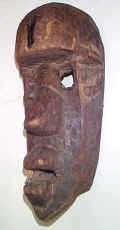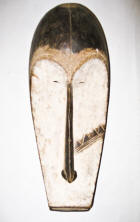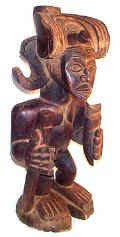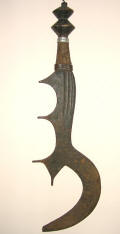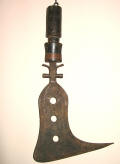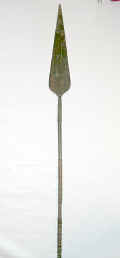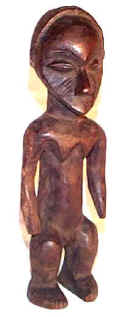DAN (DAN-GIOH, GIO, GIOH, GYO, YACOUBA, YACUBA, YAKUBA) Côte d’Ivoire, Liberia, Guinea The 350,000 Dan live mostly in the western part of the Côte d’Ivoire and into Liberia, where the land is forested in the south and bordered by a savannah in the north. They make their living from farming cocoa, coffee, rice and manioc. They also live off game and fish. The Dan have the reputation of being fierce warriors, always battling their neighbors, the We, the Guro, and the Mano. From a cultural viewpoint the Dan are close to the We populations situated in forest regions of the south, and against whom they have waged innumerable wars. Lacking a central authority, the various groups had neither a political institution nor unity. The village is under authority of a chief and a council of elders. In addition, there were male associations that attempted to bring about a socio-political unity, reinforcing rules of behavior, demanding absolute loyalty and obedience from members, and giving an initiatory education to the young. These societies called upon the tutelary spirits of the bush. The most powerful, even today, is the secret society of the leopard, the go, which, without having fully achieved its stabilizing and unifying goal, nevertheless grows from one year to the next. The leopard society acts as a major regulator of Dan life and initiates young men during their isolated periods of three to four months in the forest. In order to attain adult status, all the boys and girls of the same age-group undergo an initiation that includes, in addition to specific teaching, circumcision for the former and clitoridectomy for the latter. To underline the transitional aspect of this trial, it takes place in the world of the bush – the realm inhabited by spirits who, like the ancestors, can play a mediating role between humans and supreme being Zran. Dan people have achieved notoriety for their entertainment festivals, which were village ceremonies, but are today performed largely for important visitors. During these festivals, masked performers dance on stilts. The go master, the head of the like-named society possesses the masks and guards them in a sacred hut. All Dan masks are sacred; they do not represent spirits of the wilderness, they are these spirits. Dan masks are characterized by a concave face, a protruding mouth, high-domed forehead and are often covered in a rich brown patina. There are a variety of Dan face masks, each of which has a different function. They may be the intermediaries, who acts between the village and the forest initiation camp, may act against bush fires during the dry season, used in pre-war ceremonies, for peace-making ceremonies, for entertainment. Over time, many among them have lost their original function and have been recycled into contexts related to entertainment, emerging only for festivals or events organized for visitors. Nonetheless, the great masks live on, their even more rare appearances being reserved for times of tension, when it is important they may exercise their role of social control and their faculty to reduce conflict or settle legal wrangles. The Dan also carried small masks (less than 8”), which are sometimes called ‘passport’ masks. They were sewn onto a piece of cloth and kept in a leather pouch. They are miniature copies of a family mask and sometimes received libations. These masks also act as witnesses during initiation ceremonies and protect the owner when he is away from home. Dan masks are the real treasures of African art tradition, ranging in their expressive powers from gentle tenderness to fierce aggression. The Dan statues are not representation of ancestors or spirits. These figures, which were commissioned by powerful chiefs as three-dimensional portraits of their favorite spouses function as maternity figures with babies on their back. They are kept hidden inside houses and are only revealed during important occasions such as visits by foreign dignitaries. A woman who has distinguished herself through her hospitality and generosity will own a superb spoon of sculpted wood. This is a custom specific to the Dan. This woman’s role, in the heart of the village, is to receive and feed travelers, musicians participating in celebrations, and men who have come to help clear the fields. The spoon possesses the power to make one rich and famous and confers a sure authority over the other women. The spoons have several shapes: the most usual one has a handle fashioned after a human head, comparable to certain masks; others have handles that form pairs of legs. The carvers also produce chiefs’ staffs and female figures that seem to be prestige items, as are small figures cast in brass. |
|||||
Maternity statue. The 350,000 Dan occupy the wooded savannah region of western Cote d’Ivoire and, to a lesser degree, the east of Liberia; one also finds a few Dan villages in southeast Guinea. Traditionally cultivators of rice and manioc, the Dan also work immense cacao and coffee plantations. Farmers periodically clear the forest to add more land to their fields. They also live off game hunting and fishing. The Dan society was not centralized. Every village is under the authority of a chief and a council of elders. In order to attain adult status, all the boys and girls of the same age group undergo an initiation that includes specific teaching and circumcision for the former and the clitoridectomy for the latter. Dan figures, which were commissioned by powerful chiefs as three-dimensional portraits of their favorite spouse function as maternity figures with babies on their back and symbolize the fertility not only of the women, but also of the earth. They do not represent ancestors or spirits. These statues are kept hidden inside houses and are only revealed during special ceremonies. Material: wood Size: 18" x 9" x 6" |
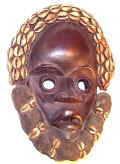 Bagle mask. Among the Dan people, masks are not controlled by a men’s association, but instead are owned by families and used by individual lineage members in contexts of social control, boy’s circumcision camps, and entertainment. Dan people have achieved special notoriety in the area for their entertainment festivals which were historically village ceremonies, but are today performed largely for honorable visitors or tourists. Visually, the Dan masqueraders show an opposition between female beauty and gentleness and male fierceness and power. The Bagle masks have typical tubular eyes. They are worn to entertain while the wearer dances, beats the musicians with a curved stick and throws objects he finds in their way. Material: wood, tissue, cowries Size: 12" x 9" x 3" |
Ceremonial spoon. Dan women have an important role in preparing a community for the arrival of masked spirits. The leaders must be sure that the women will be able to provide food for the accompanying feast. A woman who has distinguished herself through her hospitality and generosity will own a superb spoon of sculpted wood. This is a custom specific to the Dan. This woman’s role, in the heart of the village, is to receive and feed travelers, musicians participating in celebrations, and men who have come to help clear the fields. She parades through town with her female friends and family, carrying a large serving spoon as an emblem of her status. The spoon possesses the power to make one rich and famous and confers a sure authority over the other women. When the custodian of a spoon dies, a successor will be chosen by the spirit. The spoons may have different shapes. This one is of very popular type. Material: wood Size: 18" x 5" x 2" |
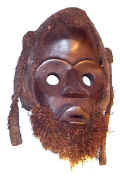 Zakpei ge or gunye ge mask. The 350,000 Dan are a farming people who inhabit the hinterland of western Côte d’Ivoire and Liberia. They have a great number of masks, which represent spirits of the bush, and fulfill a variety of social, political, and religious functions. This mask represents the classic Dan style. Circular eyeholes that permit unhindered vision on the part of the wearer are characteristic of the fire mask zakpei ge and the racer mask gunye ge, The gunye ge hold weekly running contests during the dry season, the zapkei ge also appear at this time of year, to inspect cooking fires and prevent the ever-possible conflagration. They chastise careless women with a switch, knock pots over, and take objects as security for a fine. Nowadays first, and foremost, they are danced for entertainment during village festivals. Material: wood, textile, vegetable fiber Size: 11" x 8" x 2"
|
“Passport” ma go Mask. Besides face masks the Dan carried masquettes (ma go), which are called ‘passport’ masks. They were sewn onto a piece of cloth and kept in a leather pouch and possibly worn at the back. The masquettes embody protective spirits. Sometimes they are used as a sacred object for oath taking and making sacrifices. These masquettes usually are small copies (less than 8”) of full-sized masks whose spirit may be contacted by manipulating the masquette. The “passport” masks may also act as witnesses during initiation ceremonies and protect the owner when he is away from home. Material: wood Size: 6" x 4" x 1" |
|
|
|
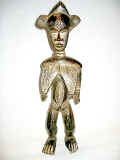 |
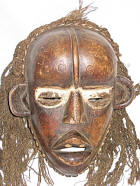 |
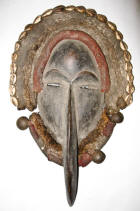 |
||
| 13" x 8" x 5" | 20" x 7" x 4" | 8" x 5" x 3" | 15" x 10" x 4" | ||
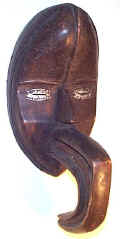 Bird Bird mask. The 350,000 Dan live in regions covered by forest in the south and savannas in the north. For the Dan people the mask is the channel of communication with the high god Zlan. The intermediaries in these communications are the spirits of the ancestors who are invoked through the mask. The Dan carve a series of wood facemasks to be worn with various costumes. This mask is an elegant, elongated composition, incorporating some features found in the feminine masks of the poro society. The slit eyes and vertical forehead tattoo are characteristic of the most frequently seen type of Dan masks. These masks are not necessarily revered as sacred messengers or obeyed as police officers; they are often the joyous companions of women, and appear at festive gatherings. In fact, forest spirits are believed by the Dan to inspire a wide variety of masquerades, including those that entertain a community. Size: 18" x 9" x 7"
|
Kagle face mask. The Dan possess numerous masks that embody bush spirits and either fulfill social tasks or appear for the entertainment. The youth who wears the mask has won a series of races, proving that he is worthy of the masquerade. Therefore athletic skills are needed by a youth who animated the kagle masquerade, danced with such an angular mask seen as masculine. During the performances the kagle steals the possessions of onlookers with his hooked stick. Those in attendance must keep their sense of humor and be willing to ransom their belongings with small sums of money. Every plane of this trickster is a clearly defined geometric form, and even the eyes are empty triangles. Material: wood Size:
|
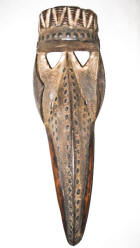 19" x 6" x 5"
|
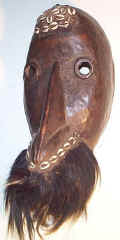 Bird (mahgle) Mask. Thia mask represents a being, part human, part bird (mah means bird, gle means mask spirit), whose functions are to entertain and inform by dancing and singing, and to bless people. The Dan believe that certain birds portend good fortune, particularly when encountered on a perilous journey. A mask carved in the likeness of these birds is believed to bring good luck to its owner and his family. Material: wood, animal hair, cowries Size: 18" x 9" x 7"
|
||
DENGESE (BONKESE, DEKESE, NDENGESE, NDENKESE) Democratic Republic of the Congo North of the Kuba kingdom situated in the Democratic Republic of the Congo, across the Sankuru River, the 12,000 Dengese people claim to be the original population of the area. Their king, known as the etoshi, reigns over local chiefs who are assisted by noble men. Powerful groups such as the blacksmith, hunting and witchcraft societies counterbalance the political power of the chiefs. While the Dengese do not use masks, their artists have produced great statues that became part of museum collections. These fine religious statues may be portraits of ancestors or funeral effigies. These statues have no lower extremities; the bodies are covered with scarifications, and figures wear bracelets and have hairdos that resemble those worn by notables, or totshi: a kind of finely braided bonnet topped with a small, wooden cylinder covered with fiber. Thus the body becomes a text. The bust and arms lengthen to accommodate the symbolic inscriptions that recall the relationship between the chief and those who are subject to his authority. The totshi belonged to an association that required enormous fees from its future members and an initiation that was performed in two stages. The statues are the funerary effigies of the totshi and represent them during the anniversary ceremony of the funeral, which would take place several months after a death. The female statue is one supposedly depicting the female founder of the association – although women are not admitted as members. The headdress, a distorted cone, represents the one placed on the king’s head during his installation and symbolizes understanding, intelligence, distinction, respect, and unity among chiefs. The placement of the hands on the belly refers to the common origins of the king’s subjects, from which he anticipates cooperation. Numerous symbols are carved on the neck and on the elongated torso and arms in imitation of scarification patterns. The patterns allude to aphorisms and praise phrases that encode the mysteries of Dengese chiefly authority. The elongated trunk, covered with a close network of scarification, is entirely different from that of the head, which is smooth, expressive and dignified. A typical flared coiffure and geometric scarifications appear on cephalomorphic scepters and drinking cups also made by Dengese. There are other carvings known from this tribe, such as a standing figure with a cup on its head, stools, and pipes. The Dengese are famous for their taste for costumes, for the decoration of their weapon, and for their metal necklaces and bracelets |
|||||
|
King or chief figure. The 12,000 Dengese inhabit the northern part of the Kasai-Sankuru stylistic region, and a large part of them live north of the Lukenye River. Their king reigns over local chiefs who are assisted by noble men. Powerful groups such as blacksmith, hunting and witchcraft societies counterbalance the political power of the chiefs. The Dengese artists are known for their sepulchral statues that became part of many museum collections. These statues are called isiki-manji and represent royal or notable ancestor figures. A distorted cone on the top of the headdress represents the one placed on the king’s head during his installation and symbolizes understanding, intelligence, distinction, respect, and unity among chiefs. The placement of the hands on the belly refers to the common origins of the king’s subjects, from which he anticipates cooperation. Numerous symbols are carved on the elongated torso and arms in imitation of scarification patterns. Special figures representing the power of a deceased king are used in investiture ceremonies in which the power of the former king is transferred to the new king. It was believed that these figures embody the king’s power. Material: wood, metal Size: 35" x 10" x 9" |
Notable woman figure. North of the Kuba kingdom, across the Sancuru River the 12,000 Dengese people claim to be the indigenous population of the area. Their king reigns over local chiefs who are assisted by noble men. Powerful groups such as blacksmith, hunting and witchcraft societies counterbalance the political power of the chiefs. The Dengese are best known for their figurative sculpture, depicting important male and female lineage members that are placed on the tombs of the deceased. The arms and torsos of the figures are carved with intricate scarifications and geometric body design. The buttocks and legs are treated in a highly schematized fashion to function as a support for the statue’s elongated torso. In particular, the Dengese artists carved the female figures, which were believed to embody their power. The female statue is one supposedly depicting the female founder of the association – although women are not admitted as members. Material: wood Size: 15" x 5" x 7" |
||||
|
DINAK (Southern Sudan) |
|||||
|
16" x 9" x 4" |
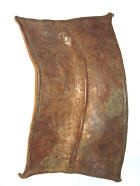 |
||||
DOGON (DOGO, DOGOM, HABBE, HABE, KADO, KADDO, KIBISI, TOMBO) Mali, Burkina Faso The 400,000 Dogon live 180 miles south of Timbuktu on the cliffs of Bandiagara, which dominate the plains for over 150 miles. They speak approximately 120 dialects, many of which are not mutually comprehensible. At first hunters, now on their small fields they cultivate millet, sorghum, wheat, and onion. The millet is stored in high quadrangular granaries around which they build their houses. Because of the difficult approach to these regions and the aridity of the climate, the Dogon have been isolated and hence were able to conserve their ancient religious habits and ways of making the necessary implements, their carvings. Dogon social and religious organizations are closely interlinked and out of this arose principal cults, which accounts for the richness and diversity of Dogon culture and art. The clans are subdivided onto lineages, overseen by the patriarch, guardian of the clan’s ancestral shrine and officiant at the totemic animal cult. Beside this hierarchical system of consanguinity, male and female associations are entrusted with the initiations that take place by age group, corresponding to groups of newly circumcised or excised boys or girls. The Dogon believe these operations remove the female element from males and vice versa. Circumcision thus creates a wholly male or female person prepared to assume an adult role. The members of an age group owe one another assistance until the day they die. Initiation of boys begins after their circumcision, with the teaching of the myths annotated by drawings and paintings. The young boys will learn the place of humans in nature, society, and the universe. In the Dogon pantheon Amma appears as the original creator of all the forces of the universe and of his descendant Lebe, the god of plant rebirth. The first Dogon primordial ancestors, called Nommo, were bisexual water gods. They were created in heaven by the creator god Amma and descended from heaven to earth in an ark. The Nommo founded the eight Dogon lineages and introduced weaving, smithing, and agriculture to their human descendants. For these various cults the hogon is both priest and political chief of the village. He is also in charge of the cult of lebe, the mythical serpent. Assisted by the blacksmith, he presides over agrarian ceremonies. The smiths and woodcarvers, who form a separate caste, transmit their profession by heredity. They may only marry within their own caste. Women are in charge of pottery making. Dogon art is extremely versatile, although common stylistic characteristics – such as a tendency towards stylization – are apparent on the statues. Their art deals with the myths whose complex ensemble regulates the life of the individual. The sculptures are preserved in innumerable sites of worship, personal or family altars, altars for rain, altars to protect hunters, in market. As a general characterization of Dogon statues, one could say that they render the human body in a simplified way, reducing it to its essentials. Some are extremely elongated with emphasis on geometric forms. The subjective impression is one of immobility with a mysterious sense of a solemn gravity and serene majesty, although conveying at the same time a latent movement. Dogon sculpture recreates the hermaphroditic silhouettes of the Tellem, featuring raised arms and a thick patina made of blood and millet beer. The four Nommo couples, the mythical ancestors born of the god Amma, ornament stools, pillars or men’s meeting houses, door locks, and granary doors. The primordial couple is represented sitting on a stool, the base of which depicts the earth while the upper surface represents the sky; the two are interconnected by the Nommo. The seated female figures, their hands on their abdomen, are linked to the fertility cult, incarnating the first ancestor who died in childbirth, and are the object of offerings of food and sacrifices by women who are expecting a child. Kneeling statues of protective spirits are placed at the head of the dead to absorb their spiritual strength and to be their intermediaries with the world of the dead, into which they accompany the deceased before once again being placed on the shrines of the ancestors. Horsemen are remainders of the fact that, according to myth, the horse was the first animal present on earth. The Dogon style has evolved into a kind of cubism: ovoid head, squared shoulders, tapered extremities, pointed breasts, forearms, and thighs on a parallel plane, hairdos stylized by three or four incised lines. Dogon sculptures serve as a physical medium in initiations and as an explanation of the world. They serve to transmit an understanding to the initiated, who will decipher the statue according to the level of their knowledge. Carved animal figures, such as dogs and ostriches, are placed on village foundation altars to commemorate sacrificed animals, while granary doors, stools and house posts are also adorned with figures and symbols. There are nearly eighty styles of masks, but their basic characteristic is great boldness in the use of geometric shapes, independent of the various animals they are supposed to represent. The structure of a large number of masks is based on the interplay of vertical and horizontal lines and shapes. Another large group has triangular, conic shapes. All masks have large geometric eyes and stylized features. The masks are often polychrome, but on many the color is lost; after the ceremonies they were left on the ground and quickly deteriorated because of termites and other conditions. The Dogon continue an ancient masquerading tradition, which commemorates the origin of death. According to their myths, death came into the world as a result of primeval man’s transgressions against the divine order. Dama memorial ceremonies are held to accompany the dead into the ancestral realm and restore order to the universe. The performance of masqueraders – sometimes as many as 400 – at these ceremonies is considered absolutely necessary. In the case of the dama, the timing, types of masks involved, and other ritual elements are often specific to one or two villages and may not resemble those seen in locations only several miles distant. The masks also appear during baga-bundo rites performed by small numbers of masqueraders before the burial of a male Dogon. Dogon masks evoke the form of animals associated with their mythology, yet their significance is only understood by the highest ranking cult members whose role is to explain the meaning of each mask to a captivated audience. |
|||||
Ceremonial vessel (Ark of the World). The Dogon are among African cultures that have remained closest to their ancestral traditions. This ancestors’ dish or Ark of the world represents the Ark (trough) in which Nommo, the father of humankind, and the various gods of the Dogon pantheon came down to earth. The carved figures correspond to founding ancestors. They brought techniques, primeval seeds, ancestors, and animals. The handles of the container recall the horses, Nommo’s incarnation after the Ark had reached the earth. The ceremonial containers were kept hidden away and taken out for the winter solstice ceremony, which brought together all the family’s blood relatives. The meat cut from sacrificed donkey and sheep was placed in the dish before being shared out. Material: wood (two parts) Size: 60" x 11" x 22"
|
Granary door. The hogon, high priest of the Dogon, inhabits a special house. Nearby stand the granaries, where millet from the hogon’s fields is stored. This harvest, used for the first sowing of the following year, brings blessings, and it is therefore sown to the accompaniment of special rites. The granaries of the hogon are larger than those of the other village dwellers, for they ensure that there will always be enough food for everyone. The granaries, like all the buildings are made of clay, and their walls are decorated with breasts formed of clay, or large Lorraine crosses like those on the kanaga masks. The granary doors were used to display peculiar carvings. This door presents conical female breasts, stylized figures of the ancestors of mankind, and figures with kanaga masks. Material: wood (two connected parts) Size: 31" x 22" x 4"
|
Ceremonial Mask. The 400,000 Dogon people inhabit the large Bandiagara plateau, with most of the villages situated on cliffs to the north and the east. Because of the difficult approach to these regions and the aridity of the climate, the Dogon have been isolated and hence were able to conserve their ancient religious habits and ways of making the necessary implements, their carvings. Over seventy anthropomorphic and zoomorphic mask types have been recorded among the Dogon. They depict a variety of mammals, reptiles, birds, persons, and inanimate objects. Each, with mythical significance, plays a specific role in the sequence of dances. The specific role of this mask is unknown. Material: wood Size: 17" x 9" x 7"
|
Statue of man with raised hands. There are about 400,000 Dogon in 700 villages which are built of mud brick and stone with clay mortar. The villages are situated on the tops or on the base of the cliffs, and on the talus slopes that line the cliffs. On their small fields they cultivate millet, sorghum, wheat, and onion exported throughout the Sudan region. The land is difficult for farming, and so the Dogon created small rectangular fields edged with stone which are fertilized with donkey manure. Like so many agricultural people of Africa, the land and its bounty plays an important part in the religious views of the Dogon. The Dogon practice the lebe cult which is primarily concerned with agricultural renewal, and altars devoted to it have bits of earth incorporated into them to encourage the continued fertility of the land. The most important agricultural rite is the bulu, which immediately precedes the first rains and planting. This figurine is related to the bulu rite. This figure with raised hands expresses a gesture of supplication to Amma (the creator of the ancestors) to bring rain, so rare in this Sahel region decimated by drought. Material: wood Size: 54" x 9" x 9" |
Ladder. Such ladders were used to enter the upper level of ginna (lineage leaders’ house). As the residence of the elder lineage head and the site of shrines to lineage ancestors, the ginna can be seen to represent order and wisdom which are considered to be especially the province of elder males. Material: woodSize: 72" x 16" x 7"
|
|
|
Satimbe mask. This is a satimbe (“sister on the head”) mask, in which the rectangular part common to most Dogon wooden masks, is surmounted by a standing female figure with outstretched arms. This figure represents yasigine, the only woman admitted to the Awa male society. These few female members of Awa stand for the collective woman who, in origin stories, first discovered masks. This occurred in primordial time before men took over the privilege for themselves exclusively, barring all women except yasigine from contact with maskers or the mask society. Notably, these are the only Dogon women whose deaths are honored with a dama. Material: wood, leather (?) Size: 34" x 21" x 6"
|
Material: wood Size: 10" x 12" x 11" |
A couple playing playing the balafon, a xylophone-like musical instrument made of wooden slats atop of gourd resonators. According to Mali's oral tradition, a balafon player and his beautiful accomplice - were crucial in defeating the evil Soso kingdom and its king Soumaworo. The sister of Mali's ruler named Sologon together with the court balafob player Bala Fasséké Kouyaté went to the enemy King undercover. Through Sologon's beauty and Kouyaté's masterful balafon playing, they discovered the source of King Soumaworo's secret powers. Sologon's brother used the information to defeat the evil king in battle. Victorious king presented the musician with the defeated king's balafon. Given that balafons are typically played by one individual, the association of two figures with this instrument may be a reference to Sologon and Bala Fasséké Kouyaté, and their important contribution to the region's history. Material: wood Size: 49" x 17" x 15" |
Material: wood Size: 52"x 11" x 10"
|
labor, but reserved the animal for the transport of important persons. The horse introduced in Africa during the second millennium BC was a creature of great prestige, a mark of particular luxury. The equestrian theme is very popular among the Dogon. The interpretation of the Dogon carvings of equestrian figures has been a subject of speculation. It is likely that the intention was to commemorate a hero or deceased leader – king, warrior, founding ancestor. Dogon equestrian figures are also believed to depict hogons—both priests and political chiefs of the village. Material: wood Size: 23" x 9" x 8"
|
|
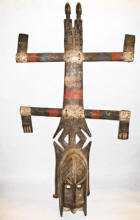 43" x 23" x 7" Dance on you-tube similar masks in use http://www.youtube.com/watch?v=xkkX1FHRgjo&feature=related THIS ITEM HAS BEEN SOLD (SWEDEN) |
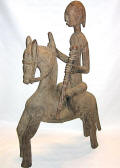 Equestrian Figure. Africans south of Sahara have never used the horse for agricultural labor, but reserved the animal for the transport of important persons. The horse introduced in Africa during the second millennium BC was a creature of great prestige, a mark of particular luxury. The equestrian theme is very popular among the Dogon. The interpretation of the Dogon carvings of equestrian figures has been a subject of speculation. It is likely that the intention was to commemorate a hero or deceased leader – king, warrior, founding ancestor. Dogon equestrian figures are also believed to depict hogons—both priests and political chiefs of the village. In his left hand he rider is holding the stuff, symbol of prestige and high position. Material: wood Size: 36" x 19" x 9" |
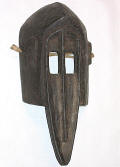 Crocodile Mask. The Dogon people inhabit the large Bandiagara plateau, with most of the villages situated on cliffs to the north and the east. Because of the difficult approach to these regions and the aridity of the climate, the Dogon have been isolated and hence were able to conserve their ancient religious habits and ways of making the necessary implements, their carvings. Over seventy anthropomorphic and zoomorphic mask types have been recorded among the Dogon. The masks evoke the form of animals associated with their mythology, yet their significance in many cases is understood only by the highest ranking cult members whose role is to explain the meaning of each mask. The crocodile mask was worn by dancers during ceremonies that protected the people from the malevolent influences of slain crocodiles. Material: wood Size: 14" x 6" x 5"
|
38" x 20" x 8"
THIS ITEM HAS BEEN SOLD (SWEDEN) |
||
DUALA Cameroon The Duala (or Douala) are an ethnic group of Cameroon. They primarily inhabit the littoral region to the coast and form a portion of the Cameroonian coastal peoples. They have historically played a highly influential role in Cameroon due to the wealth gained over years as traders and land owners. The Duala today are divided into the urban and rural. Those who live in the cities, particularly Douala itself, earn a living at a number of skilled and unskilled professions. Many Duala still own parts of the city, allowing them to live off rents and development. The rural Duala, in contrast, work as fishermen and farmers, mostly at the subsistence level. Fishing is the trade of choice. Traditional Duala society was divided into three strata. At the top were the Wonja, native Duala, with full rights of land ownership. The next tier consisted of the Wajili, either non-Duala peoples or the descendants of slaves. Finally, the Wakomi, or slaves, made up the bottom rung. Chiefs and headmen sat at the pinnacle of this hierarchy in the past, though today such figures have very little power in their own right. Instead, such individuals are more likely to own property and to have inherited wealth. Councils of elders and secret societies allow communities to decide important issues. Ancestor worship is an important part of life, althpugh majority of the Duala are Christian. Duala believe that their ancestors live in the sea. In this worldview, demi-human water spirits known as Miengu (singular: Jengu) live in the waters and mediate between worshippers and God. Other, evil sprits live in the forests and the sea. Traditional festivals held each year serve as the most visible expression of these traditional beliefs in modern times. |
|||||
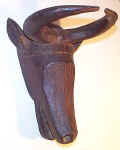 Cow Mask.
Cow Mask.Material: Wood Size: 15" x 12" x 11" |
|||||
EBRIE (GYAMAN, KYAMA, KYAMAN, TSHAMAN, TYAMA) Côte d’Ivoire The eastern cost of the Côte d’Ivoire comprises an area of lagoons, where the population is divided into twelve different language groups. Before colonization, each village was autonomous and, when threatened, they united to form a ‘confederation’. These people are not governed by chiefs, although a man’s social position is determined by his age. The two principal groups of the Lagoon area are the Ebrie and the Attye (also called Akye). The Lagoon people produced the figures, varying from 10” to 30” in height, which were usually full-frontal, standing female figures with muscular legs and arms. Typical are button-like scarifications and elaborate coiffure divided into raised masses. The figures of this kind could have served in a variety of contexts. It may have been owned by a diviner, for use in conveying messages to the spirit world, or they may have been prescribed by the diviner for a client. Alternatively, they could have been intended to represent a man’s ‘spirit lover’ from the other world, or it may have been displayed at certain traditional dances. |
|||||
|
Ceremonial figure. The two principal groups of the Lagoon area are the Ebrie and the Attye (also called Akye). The Lagoon people produced the figures, varying from 10” to 30” in height, which were usually full-frontal, standing female figures with muscular legs and arms. Typical are button-like scarifications and elaborate coiffure divided into raised masses. The figures of this kind could have served in a variety of contexts. It may have been owned by a diviner, for use in conveying messages to the spirit world, or they may have been prescribed by the diviner for a client. Alternatively, they could have been intended to represent a man’s ‘spirit lover’ from the other world, or it may have been displayed at certain traditional dances. Material: wood Size: 21" x 6" x 5" |
Ceremonial figure. The two principal groups of the Lagoon area are the Ebrie and the Attye (also called Akye). The Lagoon people produced the figures, varying from 10” to 30” in height, which were usually full-frontal, standing female figures with muscular legs and arms. Typical are button-like scarifications and elaborate coiffure divided into raised masses. The figures of this kind could have served in a variety of contexts. It may have been owned by a diviner, for use in conveying messages to the spirit world, or they may have been prescribed by the diviner for a client. Alternatively, they could have been intended to represent a man’s ‘spirit lover’ from the other world, or it may have been displayed at certain traditional dances. Material: wood Size: 16" x 4" x 4" |
||||
EGYPT |
|||||
EKOI EJAGHAM (EKOI) Nigeria and Cameroon In the Cross River region in southeast Nigeria, and over into Cameroon, several ethnicities are found and among them the Ejaghem. The oldest Cross River secret society may be the all-male Ngbe society of the Ejagham people. In their language ngbe means “leopard.” The cult of the leopard had a unifying effect on the scattered communities of the Cross River. Commercial, ritual, and social exchanges took place because of it, thus circumventing the drawbacks involved with a non-centralized regime and political institutions that often did not extend beyond the framework of the village. With the exception of forest cleaning, Ejagham farm labor traditionally was done by women. The men were free to concentrate on hunting and the arts of war. It also meant that men had leisure for the elaboration of art. They combined a love of physical combat and physical self-realization in hunting with a love of artistic fulfillment. Both women and men wove raffia cloth on upright looms; both women and men devoted loving care to the elaboration of coiffure, body paint, and dress. The Ejagham people are best known for their large, skin-covered masks, which may have one, two or even three faces, and for their headpieces, which represent a head or an entire figure. The skin-covered heads and helmet-masks are unique in Africa. Earlier skins of slaves, later skins of antelopes, were used. The elaborate trading network along the river formerly involved the selling of rights to Ngbe and other associations, including the right to perform their various masquerades. The group selling the rights would perform the masquerade in the village of the buyer group, then return home, leaving their masks and costumes behind. The river trade thus helped to spread related art events and art objects among diverse people over a broad area, though changes in both form and meaning took place as local copies of masks and costumes were made. Masks of secret societies appear in performances by accomplished dancers at funerals, initiations of new members, agricultural and other events. Two types of masks dominate: helmet masks and crest masks. The helmet mask covers the entire head of the wearer reaching to the shoulders. When the mask is made fresh animal skin is stretched and tacked over the soft wood from which it is carved. After the skin dried, it was stained with pigments made from leaves and bark. Crest masks do not cover the head but rather sit on top of it. They are attached to the basketry cap, which is held on the wearer’s head. The headpieces and masks may have metal teeth, inlaid eyes, and frequently pegs to represent hair, which, alternatively, may be carved in elaborate coils. Feathers, quills, and other objects would have ornamented the mask in performance. Human hair went into the hairdo. It is presumed that all masks represented ancestors. In addition to masks that represent human heads, there are also those that represent skulls and animals. All of these animal masks and grotesque masks are seen as fierce and frightening. The skin covering of a mask served as a magical agent to invoke ancestral spirits, thus eroding the barrier between living and dead participants in communal rituals. In the northern Ejagham area, around Ikom, are found large stones, akwanshi, from one to six feet high, carved in low relief to represent human figures. They are thought to be no earlier than the 16th century. |
|||||
|
Janus-type headdress. The Ejagham are found in the easternmost part of southern Nigeria and in the contiguous area of the western Cameroon. They are hoe agriculturists and their main crops are yam, coconut and maize. The Ejagham produced skin-covered wooden headdresses and masks of a demonic naturalism. Earlier skins of slaves, later skins of antelopes, were used. It is presumed that all masks represented ancestors. Janus-type, two-faced masks, have mythological significance: one face representing Father Heaven, the other Mother Earth. The Ejagham masquerades performances generally took place at the initiation or funerals of members of the associations, and also at periodic rites connected with agriculture. The skin covering of a mask served as a magical agent to invoke ancestral spirits, thus eroding the barrier between living and dead participants in communal rituals. Material: wood, antelope skin Size: 13" x 15" x 9" |
|||||
|
ETHIOPIA |
|||||
|
Ceremonial Head rest Material: wood Size: 7" x 6" x 4" |
Ceremonial Head rest Material: wood
Size: 7" x 7" x 4"
|
||||
EWE EWE (EVE, EVHE, KREPI) Togo and Ghana The Ewe people, who live in southern Togo and Ghana are the eastern neighbors of Asante, make small wooden statues and textiles with figurative motifs and symbols. These Aklama statues, roughly carved out of wood represent the protective spirits and are kept by the Ewe in their local shrines. Mainly the Ewe are known by their dolls. Some scholars believe that they were used only as fertility dolls, other consider them toys. The women keep these dolls under their mattresses to ensure fertility. Dolls with broken arms or legs were considered by the Ewe as more powerful. They ensured that children would be born healthy, with their arms and legs intact. The Ewe also produce clay figures of phallic form, called legba, used as tribal or family fetish representing the spirit of fecundity and generative power. Like the Yoruba people in Nigeria, they carve ibeji twins figurines, for protection of survivor after death of a twin. They also produce animal figures in black clay, copper figures in lost-wax technique, representing animals and small masks. |
|||||
Fertility doll. The Ewe live along the Coast of the Gulf of Guinea, which is a flat plain covered with shrubs occasionally interrupted by lagoons. It is divided into numerous kingdoms of which the Ewe is one of the most well known. They produce small wooden statues, textiles with figurative motifs and symbols, animal figures in black clay, copper figures in lost-wax technique, representing animals and small masks. Mainly the Ewe are known by their dolls. Some scholars believe that they were used only as fertility dolls, other consider them toys. The women keep these dolls under their mattresses to ensure fertility. Dolls with broken arms or legs were considered by the Ewe as more powerful. They ensured that children would be born healthy, with their arms and legs intact. Material: wood, beads Size: 12" x 3" x 2" |
Fertility doll. The Ewe live along the Coast of the Gulf of Guinea, which is a flat plain covered with shrubs occasionally interrupted by lagoons. It is divided into numerous kingdoms of which the Ewe is one of the most well known. They produce small wooden statues, textiles with figurative motifs and symbols, animal figures in black clay, copper figures in lost-wax technique, representing animals and small masks. Mainly the Ewe are known by their dolls. Some scholars believe that they were used only as fertility dolls, other consider them toys. The women keep these dolls under their mattresses to ensure fertility. Dolls with broken arms or legs were considered by the Ewe as more powerful. They ensured that children would be born healthy, with their arms and legs intact. Material: wood, beads Size: 11" x 6" x 4"
|
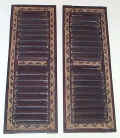 Window shutters Material: wood 42" x 15" x 1"
|
Fertility doll. The Ewe live along the Coast of the Gulf of Guinea, which is a flat plain covered with shrubs occasionally interrupted by lagoons. It is divided into numerous kingdoms of which the Ewe is one of the most well known. They produce small wooden statues, textiles with figurative motifs and symbols, animal figures in black clay, copper figures in lost-wax technique, representing animals and small masks. Mainly the Ewe are known by their dolls. Some scholars believe that they were used only as fertility dolls, other consider them toys. The women keep these dolls under their mattresses to ensure fertility. Dolls with broken arms or legs were considered by the Ewe as more powerful. They ensured that children would be born healthy, with their arms and legs intact. Material: wood, beads Size: 6" x 4" x 4"
|
Fertility doll. The Ewe live along the Coast of the Gulf of Guinea, which is a flat plain covered with shrubs occasionally interrupted by lagoons. It is divided into numerous kingdoms of which the Ewe is one of the most well known. They produce small wooden statues, textiles with figurative motifs and symbols, animal figures in black clay, copper figures in lost-wax technique, representing animals and small masks. Mainly the Ewe are known by their dolls. Some scholars believe that they were used only as fertility dolls, other consider them toys. The women keep these dolls under their mattresses to ensure fertility. Dolls with broken arms or legs were considered by the Ewe as more powerful. They ensured that children would be born healthy, with their arms and legs intact. Material: wood, beads Size: 10" x 4" x 4"
|
|
FANG (FAN, MPANGWE, PAHOUIN, PAHOUINS, PAHUINS, PAMUE, PANGWE) Gabon, Cameroon and Equatorial Guinea The people that are called “Fang” in the geographic or ethnographic literature number 800,000 and constitute a vast mosaic of village communities, established in a large zone of Atlantic equatorial Africa comprising Cameroon, continental Equatorial Guinea and nearly the whole north of Gabon, on the right bank of the Ogowe River. Historically the Fang were itinerant, and it is relatively recently that they have settled into this broad area. The migratory existence of the Fang prohibited the creation of ancestral shrines at gravesites. Instead, the remains of the important dead, in the form of the skull and other bones, were carried from place to place in a cylindrical bark box. The great rain forest region where the Fang settled is a plateau of middle altitude, cut by innumerable waters with falls and rapids rendering navigation for the most part impossible, and with a climate typically equatorial. Fang are principally hunters but also agriculturists. Their social structure is based on a clan, a group of individuals with a common ancestor, and on the family. The ensemble of Fang peoples practice a cult devoted to ancestor lineages, the bieri, whose aim is to both protect themselves from the deceased and to recruit their aid in matters of daily life. This familial cult does not monopolize the Fang’s religious universe, for it coexists with other beliefs and rituals of a more collective character. It is the bieri, or ancestor sculpture, which has most obviously given rise to the making of remarkable wooden sculpture. The statuary of the Fang can be classified into three main groups: heads on long necks, half-figures and full figures, standing or seated. Carved with great simplicity, at the same time they exhibit a high degree of sophistication in the coordination of bulbous forms. The neck is often a massive cylindrical form. The arms have various positions: hands clasped in front of the body (sometimes holding an object); held in front of the chest or attached to it; hands resting on the knees in the seated figures. The navel is often exaggerated into a cylindrical form. Legs are short, stunted. Usually there is a domed, wide forehead and the eyebrows often form arcs with the nose. The eyes are often made of metal roundlets. The bieri would be consulted when the village was to change location, when a new crop was planted, during a palaver, or before going hunting, fishing, or to war. But once separated from the reliquary chest, the sculpted object would lose its sacred value and could be destroyed. The ritual consisted of prayers, libations, and sacrifices offered to the ancestor, whose scull would be rubbed with powder and paint each time. With its large head, long body, and short extremities, the Fang bieri had the proportion of a newborn, thus emphasizing the group’s continuity with its ancestor and with the three classes of the society: the “not-yet-born,” the living, and the dead. The relics were essentially skull fragments, or sometimes complete skulls, jawbones, teeth and small bones. The bieri also served for therapeutic rituals and, above all, for the initiation of young males during the great so festival. The Fang used masks in their secret societies. The ngil (gorilla) masks were worn by members of a male society of the same name during the initiation of new members and the persecution of wrong-doers. Masqueraders, clad in raffia costumes and attended by helpers, would materialize in the village after dark, illuminated by flickering torchlight. Fang masks, such as those worn by itinerant troubadours and for hunting and punishing sorcerers, are painted white with facial features outlined in black. Typical are large, elongated masks covered with kaolin and featuring a face that was usually heart-shaped with a long, fine nose. Apparently it has been linked with the dead and ancestors, since white is their color. The ngontang dance society also used white masks, sometimes in the form of a four-sided helmet-mask with bulging forehead and eyebrows in heart-shaped arcs. The ngontang mask symbolizes a ‘young white girl’. The so, or red antelope was connected with an initiation that lasted several months; these masks sport long horns. Musical instruments – like the harp, its ends sculpted into lovely figurines – allowed communication with the hereafter. Blacksmiths bellows, many quite beautiful, were sculpted in the shape of figures; there are also small metal disks featuring heads, called “passport-masks”, the Fang attached these to their arms. Special spoons were carved and used to administer magically sustaining nourishment as part of traditional initiation rites. An individual man’s spoon was a preciously guarded possession that was carried on his person in a shoulder bag when he traveled and was placed on his tomb when he past away.
|
|||||
 Ngil ceremonial mask. The territory covered by the Fang ethnic group extends from the region of Yaounde in Cameroon to the Ogooué River in Gabon and includes Equatorial Guinea. The Fang masks are connected with the secret society known as ngil. The masters of the ngil could travel from village to village without danger because their role as peacekeepers was recognized; they were considered particularly useful in combating sorcery and evil practices, and in adjudicating between clans and rival villages. Rather than provoking any aesthetic feelings, the mask was a symbol of fear and retribution. The mask’s job was to confound the sorcerer, hunt down the social deviant, and punish the criminal. Material: wood Size: 61" x 18" x 9" |
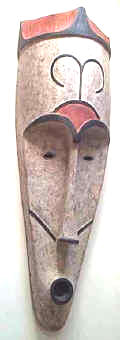 Ngil ceremonial mask. The ngil masks are tied to the superclannish association of ngil, who played judiciary and political roles among the Fang, assuring peace and hunting witches. These masks, whose apparitions in villages happened at night, had the task of punishing those guilty of vices and criminals. The characteristics of the face do not express a composed serenity, but in the deformation of anatomic characteristics reveal its superhuman and terrible character. This character is also reasserted by the use of white, the color of death and of spirits. The accentuated vertical development of the mask is underlined by the long line of the nose. The high, cylindrical forehead is followed by the convex and heart-shaped form of the eye sockets and the cheeks. The masters of the ngil could travel from village to village without danger because their role as peacekeepers was recognized; they were considered particularly useful in combating sorcery and evil practices, and in adjudicating between clans and rival villages. Material: wood Size: 57" x 15" x 6" |
 Ngil ceremonial mask. Large, elongated white-pigmented masks of this type were used in the ngil ritual, which has been, regrettably not well known. It was believed that through ritual performance, using kaolin with its protective and curative properties, ngil masks protected an individual against evil spells and poisoning. It could also enable an individual to increase his wealth. These masks were prominent in the rites of passage of male youths, and it punished the wrongdoers. Material: wood Size: 46" x 16" x 6" |
 Ngil ceremonial mask. For the Fang, the main task of the ngil male brotherhood was to combat witches and wrongdoers. The masks were also worn for the initiation of new members. Their white color, a reference to the dead, signifies that the masks embodied an ancestor spirit. The dancers burst into villages at nightfall illuminated by torchlight and accompanied by large number of acolytes. The elusive gaze of half-open eyes scans the darkness, pursuing those who violate traditions and, above all, those who cast spells, a dreaded type of sorcerer. These practices died out under colonial influence and were replaced by the arrival of the king of bogeyman in village festivities. Material: wood Size: 52" x 15" x 5"
|
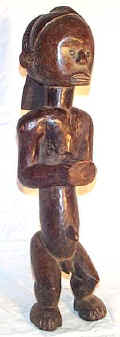 Reliquary guardian figure (bieri). The ensemble of Fang peoples practice a cult devoted to ancestor lineages, the bieri, whose aim is to both protect themselves from the deceased and to recruit their aid in matters of daily life. This familial cult coexists with other beliefs and rituals. It is, however, the bieri, which has most obviously given rise to the making of remarkable wooden sculpture. The bieri reliquaries are sorts of portative monuments. They were guarded in a dark corner of the main room, where one lived alongside them. Sometimes, deceased members of the lineage were buried in the same hut space or in that of some close relative, this to prevent someone making off with any osseous remains, to be used in sorcery against family members. The relics were essentially skull fragments, or sometimes complete skulls, jawbones, teeth and small bones. They were the objects of an “ordinary” cult consisting of regular libations by way of appeasement. The bieri served to protect the living, for therapeutic rituals and, above all, for the initiation of young males during the great so festival. The figures were then separated from the relics, to serve as ritual marionettes during the quasi-theatrical events when the candidates – duly drugged and prepared – have to “die” as children to then be “reborn” as adult men. It is by way of a hallucination that they are able to see their ancestors and, above all, come to learn their new names. Through this revelation, the candidates come to know the role of the reliquary figures. Material: wood Size: 22" x 7" x 5" |
|
|
Reliquary guardian figure (bieri). The Fang have the custom of collecting in boxes made of bark, the skulls and bones of deceased dignitaries, together with substances possessing magical properties, crowning these bieri with a sculpture in wood, which they regard as the ancestor and guardian spirit of the family, the embodiment of their entire vital force. They were guarded in a dark corner of the main room, where one lived alongside them. Sometimes, deceased members of the lineage were buried in the same hut space or in that of some close relative, this to prevent someone making off with any osseous remains, to be used in sorcery against family members. The hands of the sculpture clasp around a receptacle for medicine. Material: wood Size: 21" x 7" x 7" |
This mask has been sold Ngil ceremonial mask. The ngil masks are tied to the association of ngil, who played judiciary and political roles among the Fang, assuring peace and hunting witches. The characteristics of the face do not express a composed serenity, but in the deformation of anatomic characteristics reveal its superhuman character. This character is also reasserted by the use of white, the color of death and of spirits. The accentuated vertical development of the mask is underlined by the long line of the nose. We have little information on the use of ngil masks. They obviously were a part of the paraphernalia of a male ngil society which used the masks in initiation ceremonies and to pursue and punish sorcerers and offenders. The supposedly gentle expression of the masks therefore stands in striking contrast to the extremely frightening character of the masked performers who only performed at night in the light of torches. Material: wood Size: 40" x 9" x 8" |
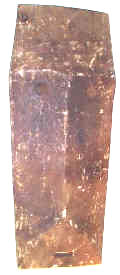 This mask has been sold Ngil ceremonial mask. The ngil masks are tied to the association of ngil, who played judiciary and political roles among the Fang, assuring peace and hunting witches. The characteristics of the face do not express a composed serenity, but in the deformation of anatomic characteristics reveal its superhuman character. This character is also reasserted by the use of white, the color of death and of spirits (here it is apparently worn). The accentuated vertical development of the mask is underlined by the long line of the nose. These masks were a part of the paraphernalia of a male ngil society which used them in initiation ceremonies and to pursue and punish sorcerers and offenders. The dances of the masked performers took place at night in the light of torches. Material: wood Size:
22" x 10" x 1"
|
Ceremonial mask. Fang masks, such as those worn by itinerant troubadours and for hunting and punishing sorcerers, are painted white with facial features outlined in black. Apparently they have been linked with the dead and ancestors, since white is their color. The ngontang dance society used white masks, sometimes in the form of a four-sided helmet-mask with bulging forehead and eyebrows in heart-shaped arcs. The ngontang mask symbolizes a ‘young white girl’. The so, or red antelope was connected with an initiation that lasted several months; these masks sport horns. This mask possibly relates to so. Material: wood Size: 18" x 9" x 6"
|
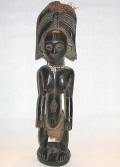 Material: wood Size: 17" x 3" x 4"
|
|
|
Ceremonial mask. Fang masks, such as those worn by itinerant troubadours and for hunting and punishing sorcerers, are painted white with facial features outlined in black. Apparently they have been linked with the dead and ancestors, since white is their color. This mask combine ngil characteristics with these of so. The so, or red antelope was connected with an initiation that lasted several months; these masks sport horns. The specific function of this mask combining mixed characteristics is not clear. Material: wood Size: 16" x 7" x 6" |
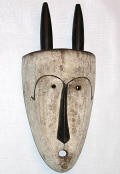 Material: wood Size: 14" x 7" x 8" |
||||
FANTE Ghana Living along the Gulf of Guinea and in adjacent inland areas (southern Ghana), the Fanti, an Akan group have distinctive arts belonging to their military companies, Asafo. Fanti military organizations have absorbed and adopted European ideas, motifs, objects, and technologies into their own artistic culture. Each state and most large communities have several Asafo companies. Each company owns certain exclusive colors, motifs, musical instruments, and other insignia, with any violation of such prerogatives by another company being considered an act of aggression. Art, then, may and does cause disputes, which in the old days erupted into virtual warfare. Painted figures and “master” drums, invariably female, are known. The Fanti are one of the peoples generally thought to not possess a masquerading tradition. The Fanti use acua’ba dolls, which differ from those of the Asante, their northern neighbors. As this is a matrilineal society, the acua’ba are female. They are used as fertility figurines in shrines or worn by women either to induce conception or, during pregnancy, to assure the birth of a beautiful child, preferably, a daughter. The acua’ba is fed, carried and bathed as if it were a living baby. If the woman has a successful delivery, the figure is returned to the shrine as a form of offering. If the child dies, the acua’ba is kept as a memorial. Usually the Fanti dolls do not have any arms and legs. They mostly appear with rectangular or elongated heads. Large elaborate drums were played during Fanti festivities. The lead drum, sometimes called queen Mother, is characterized by its legs and breasts and is covered by motifs recounting local proverbs. |
|||||
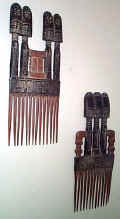 Combs. Fanti are one of the peoples generally thought to not possess a masquerading tradition. The Fanti use acua’ba dolls, which differ from those of the Asante, their northern neighbors. As this is a matrilineal society, the acua’ba are female. They are used as fertility figurines in shrines or worn by women either to induce conception or, during pregnancy, to assure the birth of a beautiful child, preferably, a daughter. These combs elaborately carved and decorated with acua’ba doll, are worn as hair ornaments. Material: wood Size: 19" x 8" x 1" each |
Fertility acua’ba figurine:. Acua’ba figurines with a rectangular head are attributed to Fanti. Akan women who have difficulty conceiving visit a local shrine where they can purchase an acua’ba figurine. The best-known use of these figurines is an aid to conception, that is, the figurine would be consecrated by a priest who invokes the influence of his cult deity to induce pregnancy. Placed for a period on the altar, it later is reclaimed by the woman. The acu’ba is fed, carried and bathed as if it were a living baby. If the woman has a successful delivery, the figurine is returned to the shrine as a form of offering. If the child dies, the acua’ba is kept as a memorial. Material: wood Size: 14" x 3" x 2" |
21" x 3" x 1" |
10" x 4" x 2" |
23" x 4" x 4" |
|
GHANA |
|||||
Most likely an acua’ba doll made for a souvenir 19" x 6" x 4" |
Nanumba 12" x 5" x 6"
|
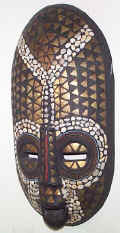 Decorative mask 22" x 13" x 4" |
|||
GIMINI |
|||||
|
17"x 8" x 4" |
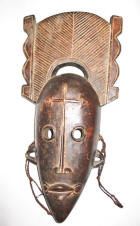 |
||||
GREBO Liberia and Côte d’Ivoire "Grebo" means "leaping monkey people," a reference to their flight from a former homeland near the Sahara. Their major economic activity is producing palm oil and palm kernels for export. The culture of the Grebo, a little-known ethnic group inhabiting the coastal region of eastern Liberia and the bordering forestlands, was shaped in a considerable degree by their neighbors to the north, the Kran and Dan. Unlike the other people living in Liberia, the Grebo are not structured by the Poro society. They are ruled by a chief known as bodio who lives in near total isolation and also assumed the function of grand priest. The Grebo sculpt several types of masks. One type is characterized by a massive face surmounted by two buffalo horns. The second type of masks represents the female ideal with slit eyes and sweetness of expression. The third type are male war masks, more abstract and flat, formed by a board with elongated nose and one or more pairs of tubular eyes. The masks appeared during rituals reserved for initiates and at the time of festive occasions, when the whole population was able to see them. The war masks designed primarily to terrify appeared during battles, in the dances beforehand, and at the funerals of warriors. Figures are rare. Their style is closely related to Dan, We and other neighboring tribes.
|
|||||
|
THIS ITEM IS SOLD War mask. "Grebo" means "leaping monkey people," a reference to their flight from a former homeland near the Sahara. Their major economic activity is producing palm oil and palm kernels for export. The culture of the Grebo inhabiting the coastal region of eastern Liberia and the bordering forestlands, was shaped in a considerable degree by their neighbors to the north, the Kran and Dan. They are ruled by a chief known as bodio who lives in near total isolation and also assumed the function of grand priest. The Grebo sculpt several types of masks. One type is characterized by a massive face surmounted by two buffalo horns. The second type of masks represents the female ideal with slit eyes and sweetness of expression. The masks of the third type to which the present mask is related are male war masks, more abstract and flat, formed by a board with elongated nose and one or more pairs of tubular eyes. The multiple pairs of eyes were possibly intended to convey the mask’s power to see hidden things, an ability thought to be possessed by sorcerers and clairvoyants. The war masks designed primarily to terrify appeared during battles, in the dances beforehand, and at the funerals of warriors. For their performance, the masks were attached to a wicker framework which the dancer wore on his head. In addition, there are indications that the backs of the masks were treated with magical substances and placed for protection and as a sign of authority in front of the village chief’s house. Material: wood Size: 49" x 11" x 8" + raffia |
|||||
GUERRE-WOBE (WE) Côte d'Ivoire and Liberia Modern ethnology puts the Wobe and Guere together under the name We, despite the fact that the people themselves use the old names. The We population is estimated at 100,000. Rice, yams, taro, manioc, maize, and bananas are the primary crops grown. Farming and hunting have been largely replaced by laboring in the diamond camps or working at the rubber plantations. Confederations govern both ethnic groups -- the largest is the warrior confederation, which is led by a military chief, who also acts as a civil authority. The family units also play an important role in We social life. The art of Guere and Wobe people is stylistically connected and both groups are often collectively referred to as We, meaning "men who easily forgive." Like the Dan, the We use a wide variety of masquerades, which hold important regulatory position within their small, egalitarian communities. Masks are owned by families and used by individual lineage members in contexts of social control, boy’s circumcision camps, and entertainment. Most We masks were created to frighten with the gaping jaws and tubular eyes. The style of these forest living people differ from the sophisticated, gentle and often refined art of the neighboring savanna-dwellers. We people produce a variety of masks often characterized by enlarged triangular nose, an open mouth and tubular eyes. We statues are rare. |
|||||
|
Bugle face mask. The We live in the southwest of the forested Côte d’Ivoire and the southeast of Liberia. They are in fact two separate tribes – the Guere (also known as Ngere) and the Wobe – although they share numerous customs and beliefs. As symbols of societal beliefs and values, their masks reinforce respect for the rules and functioning of society. The most striking feature of the We masks is often a combination of diverse materials that lends these masks tremendous expressive force. This mask represents a forest spirit. Formerly, bugle masks carried out important social control functions, including judicial decisions, law enforcement, criminal punishment, fine collection, and dispute settlement. Their aggressive, lively performance was intended to instruct in proper behavior, although in recent decades this punitive power has declined. Material: wood, fur, animal hair, ???? Size: 22" x 17" x 4" |
Kpanhi face mask. The We are in fact two separate tribes – the Guere (also known as Ngere) and the Wobe – although they share numerous customs and beliefs. The most striking feature of the We masks are the combination of diverse materials that lends these masks tremendous expressive force. We initiation is not tied to Poro societies, as is the case of their many neighbors, but masks do appear at initiation. Performances also occur during funerals and for purposes of entertainment. Although described as primarily entertainment, such performances also contain social and political commentary that serve to demonstrate to the community the wisdom of the elders. The present brightly painted and frightening mask likely represents kpanhi, or the dog-headed ape. In cases of conflict it served as the “great mask,” and when customs were violated it pointed out who committed the offense. Material: wood, vegetable fiber Size: 17" x 12" x 5"
|
Ceremonial mask. Modern ethnology puts the Wobe and Guere together under the name We, despite the fact that the people themselves still use the old names. No self-respecting Wobe would ever refer to himself as a We. The We live in the forest in the southwest of the Cote d’Ivoire and the southeast of Liberia. They have gained a great reputation as healers due to their knowledge of plants. The We have a culture related to that of the Dan. They were inventors of the “terror” masks, whose function was to establish contact with tutelary entities through the intermediary of dead ancestors. Most We masks were created to frighten. Each mask was designed for a precise purpose. In the absence of the costume, however, it is difficult to be entirely certain of the mask’s true function. Materials: wood Size: 11" x 8" x 3" |
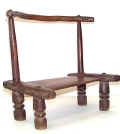 Stool: 16" x 15" x 10" |
Material: Size: 15" x 10" x 5" |
|
GURO (GOURO, GWIO, KWENI, LO, LORUBE) Côte d'Ivoire With a population of 200,000 the Guro live west of the Baule on the Côte d’Ivoire, in a heterogeneous area of free-filled savannas and dense tropical forest. Originally they were called Kweni, but they were violently colonized between 1906 and 1912 and were given the Baule name Guro by the invading French colonials. The Guro farm predominantly cotton, rice, coffee and cocoa – the men clear the field and the women plant. The daily life of the Guro is dominated by secret societies and by a belief in protective spirits, to whom the Guro used to build shrines and create figures. The most significant in this respect is the Je society, which is responsible for social, political, and juridical questions, decisions of peace and war, policing tasks, and the detection of destructive forces, as well as appearing at funerals of its members. This male society uses a variety of anthropomorphic and zoomorphic masks, some fitted with staff-like superstructures, all ostensibly fatal for women to view. Village life is regulated by a council of elders, representing each main family, and by secret societies. The art of the Guro is distinguished by extreme refinement. The Baule and Guro styles are difficult to separate. The Guro style, however, has one or two distinguishing marks: the face of the human mask is usually longish while the forehead and bridge of the nose form an elegant S-shaped profile. The tattoo pattern cut in relief on forehead and cheeks is a repetition of the short protruding tattoo marks on the men’s faces, and another characteristic of many Guro masks is the broad, wooden collar that serves as a fixture for the raffia cloak. There are polychrome, as well as black and brown polished masks. There is a much stronger tendency than with the Baule to add animal features to the human face – elephant’s ears, or a superstructure in the shape of a cockerel’s or other bird’s head. The hairdo is often carved in elaborate geometrical patterns, surmounted by horns or a totem animal. In some the nose forms an animal-like beak. Rather well known is the zamble mask combining the features of hyena, crocodile (or leopard) and antelope. Most of them are polychrome. There are also human masks with long horns and a superstructure in the form of one or two human figures. The masks are supplemented by voluminous, multipartite costumes of palm-frond strips or reed-grass, which completely conceal the dancer’s body. At ceremonies the Je animal masks are the first to appear, and they prepare the audience for the performance of the more powerful, anthropomorphic figures. Guro artists also carved figures, which appear either during entertainment festivals on the head of a dancer, or are kept in houses and employed as divination figures. These standing figures are carved with their hands on their hips and have a columnar neck supporting a head with similar features to the face masks. Their beautiful weaving-loom pulleys are surmounted with heads, often female, of great elegance, embodying the protective spirit of labor. |
|||||
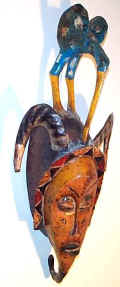 Gu woman mask . The Guro are related by language and culture to their western neighbors, the Bete and Dan, yet their art has greater affinity with that of the Baule and Yohure to the east. The daily life of the Guro is dominated by secret societies and by a belief in protective spirits, to whom the Guro used to build shrines and figures. The Guro have a very pronounced artistic sense and attach special importance to hairdos, so that hairdressers are considered to be artists. The best-known cult among the Guro relates to a group of masks that is considered a family. It consists of several animal masks and gu, a woman mask. Gu, who is usually thought of as zamble’s wife (zemble is a creature combining the features of hyena, crocodile or leopard, and antelope), performs during the ceremony for resolving quarrels and detecting sorcerers, or dances at funerals and other ceremonies. During her performance, which is accompanied only by flute music, gu moves slowly and gracefully, singing songs in honor of zamble. Material: wood Size:24" x 11" x 6" |
Spirit mask. The 200,000 Guro people live west of the Baule, in a heterogeneous area in some places containing free-filled savannas, in others, dense forest. The Guro farm predominantly cotton, rice, coffee, and cocoa - the men clear the fields and the women plant. Village life is regulated by a council of elders, representing each main family, and by secret societies. The Guro have a very pronounced artistic sense. Their art is related to Baule and is often characterized by gentle and skillful combination of human and animal forms. The daily life of the Guro is dominated by a belief in protective spirits, to whom the Guro used to build shrines and figures. This very unusual mask where human face features are strangely combined with unreal ones presents a spirit. Its specific meaning and function are not clear. Material: wood Size: 15" x 10" x 10"
|
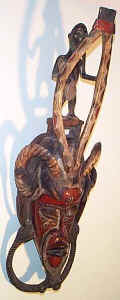 The Guro are related by language and culture to their western neighbors, the Bete and Dan, yet their art has greater affinity with that of the Baule and Yohure to the east. The daily life of the Guro is dominated by secret societies and by a belief in protective spirits, to whom the Guro used to build shrines and figures. The Guro have a very pronounced artistic sense and attach special importance to hairdos, so that hairdressers are considered to be artists. The best-known cult among the Guro relates to a group of masks that is considered a family. It consists of several animal masks and gu, a woman mask. Gu, who is usually thought of as zamble’s wife (zemble is a creature combining the features of hyena, crocodile or leopard, and antelope), performs during the ceremony for resolving quarrels and detecting sorcerers, or dances at funerals and other ceremonies. During her performance, which is accompanied only by flute music, gu moves slowly and gracefully, singing songs in honor of zamble. Material: wood Size: 27" x 9" x 7 |
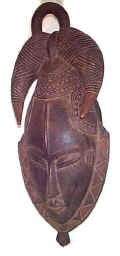 Spirit mask. The Guro people numbering about 200,000 live in the interior part of the country, surrounded by savannah and forest. The Guro are related by language and culture to their western neighbors, the Bete and Dan, yet their art has greater affinity with that of the Baule and Yohure to the east. The Guro farm predominantly cotton, rice, coffee, and cocoa - the men clear the fields and the women plant. Village life is regulated by a council of elders, representing each main family, and by secret societies. The daily life is dominated by secret societies and by a belief in protective spirits, to whom the Guro used to build shrines and figures. The Guro have a very pronounced artistic sense. This mask where human face is combined with antelope horns presents a female forest spirit. Its specific meaning and function are not clear. Material: wood Size: 18" x 8" x 4" |
Antelope zamble mask. The Guro people numbering about 200,000 live in the interior part of the country, surrounded by savannah and forest. Village life is regulated by a council of elders, representing each main family, and by secret societies. The Guro farm predominantly cotton, coffee and cocoa – the men clear the field and the women plant. Guro art is characteristically elegant. Their artistic output is dominated by masks. This Zamble bushbuck antelope mask is one of the three yu masks found among the northern Guro. The term yu can designate the association, all its objects, or one mask. Occasionally the trinity consisting of zauli, a horned mask with distended cheeks, zamble, and its daughter, gu, is reduced to a zamble-gu pair. Masks of this type are usually worn by two dancers, one mask representing the male, the other the female. They are used to detect and extinguish evil forces. Size: 15" x 7" x 6"
|
|
| GURUNSI | |||||
HEMBA Democratic Republic of the Congo In southeast DRC, the 90,000 Hemba people inhabit the right bank of the Lualaba River. This region presents vast plains surrounded by high hills and bordered by streams, rocks, and marshes. They are primarily subsistence agriculturalists whose main staples include manioc, maize, peanuts, beans and yams. These crops are supplemented by small scale hunting and fishing done mostly by the men. Some alluvial copper is panned from the river and sold to outside markets. Their social organization is founded on a system of clans that brings together several families sharing a common ancestor. They recognize a creator god Vidiye Mukulu and a supreme being ShimuGabo. The Hemba practice ancestor worship, not only to keep the memory of their great chiefs alive, but also to justify the present authority and power of the chief of the clan; the latter has absolute authority over clan members and is in charge of several ancestor figures he keeps in his own hut or in a smaller, funerary hut. The chief of the clan renders justice and his status as clan head means that he has the privilege of receiving numerous gifts. As celebrant of the ancestral cult, the chief of the clan, surrounded by the people, communicates with the ancestor, recalling his great deeds and summoning his good will. He renders justice in his own home, and collects tributes for it. Along with medicine, law, and sacrifices, the ancestral cult penetrates all social, political, and religious domains. To possess numerous effigies is a sign of nobility. Secret societies such as Bukazanzi for the men and Bukibilo for the women counterbalance the chief of the clan’s power. Diviners play an important role in society, often requiring that certain ancestors be appeased in order to establish balance in the community. The Hemba are a matrilineal people with a sculptural tradition devoted mainly to representation of male ancestors. The sculptures of the Hemba include singiti male ancestor figures and two types of masks. Although every figure is the portrait of a specific person, the artist portrays generalized, not particular, individual traits. The figures express equilibrium, symmetry and refinement. The sculptural beauty reveals the highest moral qualities. The Hemba see the serenely closed eyes and the rounded face as reflecting the ancestor’s interior calm. A four-lobed hairdo typical for many Hemba figures evokes the four directions of the universe and the crossroad where spirits assemble. Hands on each side of the swelling belly indicate the ancestor embracing and watching over descendants. They are called upon by the chief of the clan who is in charge of them, in a dialogue recalling the valiant deeds of the ancestor in return for his benevolence. The Hemba honor the kabeja, a Janus-shaped statuette, with a single body and two faces, male and female, on one neck. The kabeja is topped with a receptacle for magic ingredients. Each clan possesses a single kabeja, which is dangerous to handle, and which receives sacrifices intended for the spirits, a magico-religious practice that is of the essence to the family. The first type of masks that are rare presents a symmetrical human face with a small mouth and a linear nose set between two slanted eyes. The second type is used in So’o, a semi-secret society. It represents a strange were-chimpanzee with a large, pierced, crescent-shaped mouth and a pointed nose. The function and meaning of these masks remains obscure. The Hemba also sculpt anthropomorphic neck-rests, rattles used in dancing, and ivory objects. |
|||||
|
Ancestor figurine. The Hemba people numbering 80,000 inhabit vast plains surrounded by high hills and bordered by streams, rocks, and marshes. Farmers and hunters, the Hemba practice ancestors worship to justify the present authority and power of the chief of the clan. Among the Hemba, sculptured male bearded figures posed standing with their hands placed on the abdomen, at the sides, or holding the beard represent distinguished ancestors. They are considered to be portraits of specific individuals and were kept in the homes of the principal Hemba families as genealogical references. The hereditary chief of each clan is the keeper of the ancestor figures. As celebrant of the ancestor cult, the clan’s chief, surrounded by his people, communicates with the ancestors, recalling his great deeds and summoning his good will. He renders justice and his status as clan head means that he has the privilege of receiving numerous gifts. Material: wood Size: 9" x 5" x 3" |
The singiti (ancestor statue). In southeast DRC, the 80,000 Hemba people inhabit vast plains surrounded by high hills and bordered by streams, rocks, and marshes. They live mostly from farming manioc, sesame, yams and beans. Their social organization is founded on a system of clans that brings together several families sharing a common ancestor. The Hemba practice ancestor worship, not only to keep the memory of their great chiefs alive, but also to justify the present authority and power of the chief of the clan who has absolute authority over clan members and is in charge of several ancestor figures he keeps in his own hut or in a smaller, funerary hut. This singiti ancestor statue (they are usually male) exhibits dignity and power. Material: wood Size: 32" x 12" x 14"
|
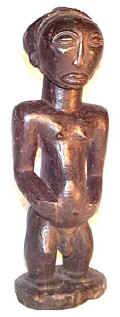 THIS ITEM IS SOLD Ancestor figure. The Hemba are primarily subsistence agriculturalists whose main staples include manioc, maize, peanuts, sesame, yams and beans. These crops are supplemented by small scale hunting and fishing done mostly by the men. Some alluvial copper is panned from the river and sold to outside markets. The Hemba practice ancestor worship to justify the present authority and power of the chief of the clan. The veneration of ancestors is an important feature of life in large Hemba families. The ancestor’s figures are traditionally carved with hands placed on either side his stomach; it indicates that he is watching over the clan. The ovoid face is full and round, suggesting interior calm; the hair is dressed with a carved diadem, the beard frames the face. Material: wood Size: 18" x 6" x 4" |
Mwisi wa so’o mask. In southeast DRC, the 80,000 Hemba people inhabit vast plains surrounded by high hills and bordered by streams, rocks, and marshes. They are primarily subsistence agriculturalists whose main staples include manioc, maize, peanuts, beans and yams. The mwisi wa so’o mask is used in So’o, a semi-secret society. It represents a strange were-chimpanzee, partaking of characteristics of both the animal and the human order, but really being of neither. The wide, grimacing mouth is regarded as horribly strange. High raised brows, forming a counter curve to that of the mouth, are associated with wildness and craziness. The entire configuration of the mask, worn with a wig and beard of white and black monkey hair, suggests an untamed, uncontrolled presence. So’o is like a spirit of the deceased, not yet installed in the world of the dead, no longer part of the world of the living. The masked dancer conjures up the chaotic, terrifying hereafter when he appears at funeral ceremonies and commemorations dressed in animal skins and bark, and performs his wild, unbridled dances, causing the people to flee in horror. Material: wood Size: 11" x 7" x 2"
|
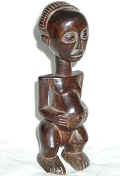 Female ancestor figurine. The vast Luba territory, comprising the entire southeastern part of the DRC, as far as Tanganyika and Lake Mweru, is uniform as regards language and culture, but racially mixed. Although the history of the Luba people is one of violence and warfare, their artistic style is characterized by harmonious integration of organically related forms. The traditional carvings are for ancestor and spirit cults, for initiation, medical and divination purposes. The favorite theme in sculpture was woman since, according to a Luba myth, vilie was the first woman spirit, founder of the clan and guarantor of fertility and the lineage. Women were cult guardians, and the royal wives played an important role: sent as emissaries to the chiefs of neighboring ethnicities, they would contract profitable political alliances based on marriage. Material: wood Size: 9" x 3" x 3" |
|
|
IGBO (IBO) Nigeria Living mainly in the forested areas of south-west Nigeria, on both sides of the Niger River the Igbo number some ten million individuals. Mainly farmers and merchants, they also hunt and fish. They are subdivided into thirty-three subgroups and are spread out among about two hundred villages scattered through the thick forest or semifertile marshland. Only on the northern and western edges of the area, under influence from Igala and Benin, are hereditary rulers found. The heads of families form the council of elders, which shares its power with numerous secret societies. These societies exercise great political and social influence. They are highly hierarchical, their members passing from one level to the next. There is strong social pressure toward individual distinction, and men can move upward through successive grades by demonstrating their achievements and their generosity. The lack of overall centralization among the Igbo-speaking peoples has been conducive to the development of a great variety of art styles and cultural practices. The earliest sculpture known from Igboland is from the village of Ibo Ukwu, where the grave of a man of distinction and a ritual store, dating from the 9th century AD, contained both chased copper objects and elaborate castings of leaded bronze. Ibo sculpture is subject to rather strict rules: the figures are generally frontal, symmetrical, and upright, with legs slightly spread, arms held away from the body, and hands stretched forward, palms open. Proportions are true to those of the human body, with the exception of the neck, which is more elongated. The whole gives the impression of balance and stability yet lacks the degree of refinement and precision. The altar statues called ikenga are sculpted from hard wood. They include a pair of horns, identified as the horns of a ram who “fights with his head” – hence is symbolic of aggression and perseverance. Since the ram rarely fights, he therefore symbolizes self-control and determination to the Igbo. The statue is scarified to reflect the status of its owner. Young men acquire an ikenga at various ages, but they all own one of them by the time they get married and settle down. The large ikenga belong to whole communities, age groups, or lineages. They are characterized by complex hairdos, which, again, use the theme of horns. These statues are displayed during ceremonies and strengthen the sense of community solidarity. The alusi figures are the protective divinities associated with elements of nature (the rivers, the earth) or social elements (markets, ancestors). They are gathered in sanctuaries on the model of familial Igbo groups, and – in the hairstyles, the scarring, and the ornaments – they present the status symbols of influential people. There is a recurrent element in the palms of the hands, turned one to the other to indicate frankness, the openness to giving and receiving, the relationship of reciprocity that exists between men and gods. The Igbo use thousands of masks, which incarnate unspecified spirits of the dead, forming a vast community of souls. The outstanding characteristic of the many Igbo masks is that they are painted chalk white, the color of the spirit. Masked dancers wore extremely elaborate costumes (sometimes ornamented with mirrors) and often their feet and hands were covered. With their masks, the Igbo oppose beauty to bestiality, the feminine to the masculine, black to white. The masks, of wood or fabric, are employed in a variety of dramas: social satires, sacred rituals (for ancestors and invocation of the gods), initiation, second burials, and public festivals, which now include Christmas and Independence Day. Some masks appear at only one festival, but the majority appear at many or all. Best known are those of the Northern Ibo mmo society, which represent the spirits of deceased maidens and their mothers with masks symbolizing beauty. Among the Southern Ibo, the ekpe society, introduced from the Cross River area, uses contrasting masks to represent the maiden spirit and the elephant spirit, the latter representing ugliness and aggression and the former representing beauty and peacefulness. A similar contrast is found in their okorosia masks, which correspond to the mmo of the Northern Ibo. The Eastern Ibo are best known for masquerades associated with the harvest festival, in which the forms of the masks are determined by tradition, though the content of the play varies from year to year. Stock characters include Mbeke, the European; Mkpi, the he-goat; and Mba, which appear in pairs, one representing a boy dressed as a girl mimicking the behavior of a girl, the other representing the girl being satirized. A great many other decorative wooden objects are made, including musical instruments, doors, stools, mirror frames, trays for offering kola nuts to guests, dolls, and a variety of small figures used in divination. |
|||||
|
Ikenga Figure. The name derives from I-ke, meaning “strength” or “power”; thus, ikenga means “place of strength.” These statues include horns, identified as the horns of a ram, who “fights with his head” – hence is symbolic of aggression, and perseverance. Since the ram rarely fights, he therefore symbolizes self-control and determination to the Igbo. In Igbo society there is strong social pressure toward individual distinction, and men can move upward through successive grades by demonstrating their achievements and their generosity. One of the traditional representations of this was the ikenga, that part of oneself enabling personal achievement, with cult figures representing the attributes of distinction. Young men acquire an ikenga at various ages, but they all own one of them by the time they get married and settle down. To the Igbo the ikenga statue embodied a protective spirit for success, for achievement, a well-known motivating force among the Igbo. It was also considered a house-protective statue and consulted before undertaking a new enterprise, before going on a journey or hunting, or in general for good luck. It was placed on the house altar. The large ikenga like this one belong to whole communities, age groups, or lineages. They are characterized by complex hairdos, which, again, use the theme of horns. These statues are displayed during ceremonies and strengthen the sense of community solidarity. Material: wood Size: 78" x 16" x 16" |
Shrine (alusi ) statue. The religious beliefs and practices of Igbo speaking peoples identify a constellation of tutelary deities known as alusi or agbara. These unseen, proximate deities (encompassing places, principles and people) include the earth, rivers and other prominent features of the landscape, markets, war, remote founding ancestors and legendary heroes. Overall the deities and their cults are considered responsible for the health, prosperity and general well-being of the people and the productivity of field and stream. This figure represents one of the numerous Igbo alusi deities with children. They are gathered in sanctuaries on the model of familial Igbo groups, and they present the status symbols of influential people. Conceived for frontal vision, they have a symmetrical appearance. During annual festivities, these figures are taken out and paraded through the village. Material: wood Size: 47" x 10" x 3" |
Figure of Ala, goddess of the earth. Shrines called mbari are specially constructed sites of ritual objects and activity. The Igbo gods are understood through the model of the family. Larger sculptures represent the more important male and female gods, often considered to be “married” to one another and to be “parents” of lesser deities. These gods are nature gods such as earth, rivers, and forests. They protect and heal in return for respect, sacrificial food, and adherence of their rules. The gods are beneficent or malevolent, depending on how humans treat them. The majority of mbari are built for Ala¸ goddess of the earth, often the most powerful local deity. The goddess is presented here with her children. Material: wood Size: 3" x 12" x 11" |
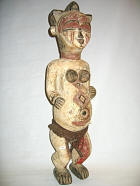 Size: 23" x 12" x 11" |
Female ancestor figure. The Igbo numbering from seven to ten million occupy the plateaus of southern Nigeria. The majority of Igbo are farmers. Their staple crop is yam, and its harvesting is a time for great celebration. They also hunt and fish, and are involved in commerce. The lack of overall centralization among the Igbo-speaking peoples has been conducive to the development of a great variety of art styles and cultural practices. This female figure, seated and smoking upon a stool, is adorned with representations of ivory bangles at wrist and ankle and strings of large beads around the neck. Complex scarification marks are shown on the face and body. This figure probably represents a female ancestor, and would have been employed in funeral ceremonies connected with the matrilineage, an institution called Ekwotame by the Idoma. Material: wood Size: 18" x 12" x 8"
|
|
IDOMA Nigeria Living at the confluence of the Benue and Niger rivers, the 550,000 Idoma people are predominantly farmers and traders. They grow yams, millet and sorghum, and place these cultivations at the heart of their festivals. As farmers, they have a long market tradition in a region of neighboring ethnic groups who have intermarried with one another. The Idoma believe in a creator god, but different cults are entrusted to the various societies. The alekwu society is responsible for the cult of the periodic resurrection of the ancestor who plays a vital social function. The secret society of the aiuta is in charge of maintaining order; its members, village chiefs and dance groups, remain under the control of elders. The oglinye society groups together the royal lineage, which have the right to own the masks. The Idoma give their ancestors an important place in daily life. The resurrection of the dead is an important element of their religion and the cult of the spirits of nature, Anjenu, is celebrated through the mediation of figures preserved in shrines. In particular, a protective spirit lives in the water or the forest and may appear in dreams. Generally benevolent, an Anjenu favors commercial transactions, helps to cure illness and, above all, aids female fertility. The Anjenu was invoked by men who wanted their wives to become pregnant. Protruding conical breasts and navels are common. The face is usually painted with white pigments -- a stylistic characteristic often shared with Ibo people. Seated statues with one or several children are believed to incarnate fertility, a frequent theme in the region. Idoma people also make face and helmet masks. The bush spirit Anjenu who lives in the rivers is honored during ceremonies involving mortuary masks with white faces, silted eyes, and teeth impregnated with kaolin. The Idoma sculpt masks of various forms which relate, be it in this world or in that of the beyond, to the exercise of justice. The manifestation of masked ancestors signifies their presence into the world of the living. The spirits’ return is, thus, the key element underlying Idoma religious thoughts. Occupying an eminent position at the society’s very heart, the ancestors are special mediators of relations between the Idoma and the supernatural forces that surround them. They also incarnate the memory of the Idoma people, for their apparition serves as pretext for the public recital of their genealogies and history. Face masks are worn by dancers during funerals, typical for them are specific shape of scarification, open mouth and smooth coiffure.
|
|||||
|
Female ancestor figure. Living at the confluence of the Benue and Niger Rivers, the 500,000 Idoma people are predominantly farmers and traders. As farmers, they have a long market tradition among neighboring ethnic groups. The resurrection of the dead is an important element of their religion, and the cult of the spirits of the nature is celebrated through the mediation of masks and figures preserved in shrines. At least two types of female figures can be distinguished. The first, knowing as anjenu, is used during fertility cults and is revered in small shrines. Once a year they are worn by dancers and paraded through the village. The second type, shown here and called ekwotame, is carved as a seated woman and may be painted with red, white or black pigment. These figures represent ancestors and thus the idea of lineage. These images, ‘spirits with breasts’, are when in use adorned with various jewels. Material: wood Size: 40" x 13" x 11" |
|||||
|
IGALA ???? |
|||||
|
8" x 5" x 3" |
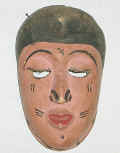 |
9" x 7" x 3" |
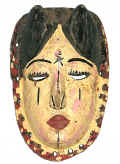 |
This mask is very similar to the mask in a Headdress representing a water spirit Temne, Ode Lay association. Sierra LEone, Mid 20th Centruty Charles B. Benenson, B.A. 1933 Collection. Source: African Arts volume 40 number 2 Summer 2007 p. 49 2006.51.275 "Hot Space, Cool Space The reinstallation of the African Collection in the Louis Kahn Building at Yale University | |
IJO (IJAW) Nigeria Numbering 200,000 to 350,000, the Ijo people live mainly in the creeks and mangrove swamps of the Niger Delta area. Being fishermen and traders they depend upon the water for food and communication. The Ijo are divided into two groups: the Kalabari-Ijo, east of the Nun River, and the western or central Ijo, who live to the west and northwest of this river. The art of both groups is characterized by a schematized approach, whereby most works of the central Ijo evince a higher degree of stylization and abstraction than those done in the Kalabari regional style. Yet also found in the western area are more realistic masks in the form of fish or animals, which are worn on the forehead. However, the best known forehead masks of the central Ijo, which embody water spirits (owuamapu), contain depictions of human heads built up of geometric shapes and combined with zoomorphic or abstract elements. Besides ancestors and deceased local heroes, water spirits play an important role in the religious ideas of the Ijo. They believe that these spirits are like humans in terms of their strengths and weaknesses and that before their birth, human beings live among them. Once born, the Ijo maintain contact with them through prayers in order to gain their favors. Celebrations in honor of the water spirits lasting several days are held annually, either at the beginning of the year or the time of high water, in order to gain the spirits’ goodwill and insure the group’s welfare. In the course of festivities various masqueraders embodying the water spirits perform, and the presence of the spirits, by whom they feel possessed, is manifested in the intensity of their dancing. The Ijo masks for the cults of the water spirits are made in the form of aquatic animals, especially hippopotamus and crocodiles.The western Ijo use the figures, in which the head of the household is represented upon a highly schematic quadruped that is said to represent the guardian spirit of the family. Among the eastern Ijo, shrines for the water spirits have figures that are often large though frequently kept hidden. They also have masks, similar to those of the western Ijo, worn by men of the Ekine society. In addition, there are shrines that contain sculptures for the village heroes and ancestors. In some Kalabari communities, rectangular screens are fashioned by carpentry into a low-relief frontal group in which a commemorated ancestor is flanked by supporting figures. All Ijo sculpture exhibits a four-square schematic style that contrasts starkly with the relative naturalism of surrounding styles, such as those of Yorubaland or Benin.
|
|||||
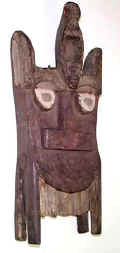 Kalabari group of the Ijo (Ijaw), NigeriaWater spirit otobo (hippopotamus) mask. Numbering 200,000 to 350,000, the Ijo people live mainly in the creeks and mangrove swamps of the Niger Delta area. Being fishermen and traders they depend upon the water for food and communication. The Ijo are divided into two groups: the Kalabari-Ijo, east of the Nun River, and the western or central Ijo, who live to the west and northwest of this river. With the Kalabari, otobo is one of the most important masks, which appears at celebrations in honor of the water spirits. This mask, formally a loose interpretation of a hippopotamus head, is actually a composite spirit, for it mingles animal and human features. Otobo is described by the Ijo as a being, who is part human part hippopotamus, and whose power enables him to withstand even terrible floods. In performance, otobo is worn on the top of the dancer’s head, facing the sky. The costume dramatizes the importance of cloth. Material: wood21" x 8" x 3" |
|||||
JOKWE, CHOKWE (BAJOKWE, BATSHIOKO, JOKWE, TCHOKWE, TSHOKWE) Angola, Democratic Republic of the Congo and Zambia More than one million Chokwe (at least 30 different spellings -- all based upon the name these people call themselves, Kocokwe, in plural Tucokwe) have spread out over a wide area in the eastern Angola, southern DRC and Zambia. Their history dated back to the 15th century, when a Lunda queen married a Luba prince Chibinda Ilunga. A significant member of the Lunda aristocracy so disapproved of the marriage that they migrated south to present-day Angola. Once settled, they founded several kingdoms, each headed by a god-king. Around 1860, following a major famine, the Chokwe people migrated back and settled in Angola, at the source of the Kwangi, Kasai and Lungwe rivers. The Chokwe are governed by a king called Mwana Ngana, who distributes hunting and cultivation areas. The male Mugonge and female Ukule societies regulate their social life. They are vigorous and courageous hunters and agriculturists, who used formerly to engage in the slave trade. Their dynamic spirit is also reflected in their art. Chokwe sculptors were the most famous of the region; there were two types. The songi made jinga charms, the small mahamba figures for the family shrines, and all objects used for hunting, love, magic, and fertility. In addition to the folk art, somewhat rigid and giving no illusion of depth, there existed also the ancient refined culture of the court, expressed with conviction by professional artists the fuli. They were hired by the great chieftainries and worked exclusively for the court. They sculpted scepters, thrones with figurines, fans, tobacco boxes, pipes, flyswats, cups, and figures of chiefs or ancestors – all demonstrating a great deal of refinement. They were famous for their large statues of deified ancestors, exalting strength and dignity. The best-known representation of a chief is of Chibinda Ilunga. He was a wandering hunter, youngest son of the great Luba chief Kalala Ilunga. He got married a Lunda queen Lueji. Chibinda Ilunga was the start of the sacred dynasty of the Mwata Yamvo of the Lunda and became the model of the hunting and civilizing hero, sometimes represented seated on a throne, sometimes as standing naked or dressed as a hunter. As statues of him were sculpted after the introduction of firearms, generally the standing figure is holding a stone rifle in his left hand and a stick, called cisokolu, in his right. Chibinda Ilunga’s body is stocky, with legs bent, shoulder blades clearly drawn, the neck wide and powerful, the navel protruding. He wears an enormous hairdo, the sign of princely rank. The social organization, founded upon matrilineal lineages, has an equally large number of female statues, whether these be identified as the queen mother or a chief’s wife. The most powerful and important Chokwe mask is known as chikunga. Highly charged with power and considered sacred, chikunga is used during investiture ceremonies of a chief and sacrifices to the ancestors. These masks are made of barkcloth stretched over an armature of wickerwork, covered over with black resin and painted with red and white designs. Chikunga is worn only by the current chief of a group. The mukanda masks play a role in male initiation. The mukanda is an initiatory institution through which religion, art, and social organization are transmitted from one generation to the next. Mukanda training lasts from one to two years. Boys between the ages of about eight and twelve are secluded in a camp in the wilderness, away from the village. There they are circumcised and spend several months in a special lodge where they are instructed in their anticipated roles as men. As part of their instruction, the boys are taught the history and traditions of the group and the secrets associated with the wearing and making of masks. Mukanda masks are also made of barkcloth over an armature of wicker. They are covered with a layer of black resin, which can be modeled before it is ornamented with pieces of colored cloth. While in former times they probably played important roles in religious beliefs and institutional practices, many other Chokwe masks have come to be used primarily for entertainment. Itinerant actors wearing these masks travel from village to village, living on gifts received at performances. Most masks are carved of wood. The most popular and best-known entertainment masks are chihongo, spirit of wealth, and pwo, his consort. Gaunt features, sunken cheeks, and jutting beard of an elder characterize a chihongo mask. Chihongo was formerly worn only by a chief or by one of his sons as they traveled through their realm exacting tribute in exchange for the protection that the spirit masks gave. While chihongo brings prosperity, his female counterpart, pwo, is an archetype of womanhood, an ancestral female personage who encourages fertility. As an ancestor, she is envisioned as an elderly woman. The eyes closed to narrow slits evoke those of a deceased person. The facial decoration on the surface are considered female. Recently pwo has become known as mwana pwo, a young woman. It represents young women who undergone initiation and are ready for marriage. During the 17th century many Chokwe chiefs were introduced to chairs imported by Portuguese officials and adopted the foreign style for their thrones. However, Chokwe style and decoration were saved. The figures on the back, stretchers, and legs were typical Chokwe carving. The Chokwe have influenced the art of many neighboring peoples, including the Lunda, Mbunda, Luvale, and Mbangani. |
|||||
|
|
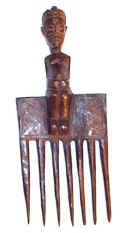 Comb with female figure. This comb features a female ancestor seated on a stool in a formal, frontal position. Material: wood Size: 8" x 4" x 1"
|
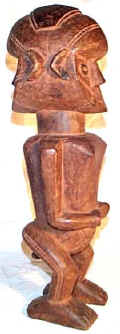 Janus-bodied figure Male face and body on one side and female on the other. Arms folded on the female side. This sculpture bears artistic elements of Tabwa people with wom Chokwe The purpose of this figure is a mystery. Material: wood Size: 19" x 8" x 8"
|
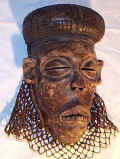 Pwo woman mask. While in former times the masks probably played important roles in religious beliefs and institutional practices, now many Chokwe masks have come to be used primarily for entertainment. Itinerant actors wearing these masks travel from village to village, living on gifts received at performances. Most masks are carved of wood. The most popular and best-known entertainment masks are male chihongo, and pwo, his consort. The pwo mask represents a female ancestor who had died young. The pwo mask is an archetype of womanhood. As an ancestor, she is envisioned as an elderly woman. Recently pwo has become known as mwana pwo, a young woman who undergone initiation and is ready for marriage. In terms of dance masks, the pwo is the incarnation of the female ancestor who encourages fertility; it is worn by a man dressed in a net tunic. It brings fecundity to the spectators, and it sometimes dances with a statuette that represents a mother carrying her child on her back. Among the mask’s typically Chokwe stylistic features are the slit eyes carved within sunken orbits, filed teeth, and facial scarifications that indicate the maturity of the female ancestor and visibly denote Chokwe identity. Material: wood |
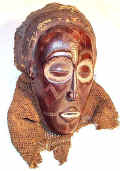 Pwo woman mask. While in former times the masks probably played important roles in religious beliefs and institutional practices, now many Chokwe masks have come to be used primarily for entertainment. Itinerant actors wearing these masks travel from village to village, living on gifts received at performances. Most masks are carved of wood. The most popular and best-known entertainment masks are male chihongo, and pwo, his consort. The pwo mask represents a female ancestor who had died young. The pwo mask is an archetype of womanhood. As an ancestor, she is envisioned as an elderly woman. Recently pwo has become known as mwana pwo, a young woman who undergone initiation and is ready for marriage. In terms of dance masks, the pwo is the incarnation of the female ancestor who encourages fertility; it is worn by a man dressed in a net tunic. It brings fecundity to the spectators, and it sometimes dances with a statuette that represents a mother carrying her child on her back. Among the mask’s typically Chokwe stylistic features are the slit eyes carved within sunken orbits, filed teeth, and facial scarifications that indicate the maturity of the female ancestor and visibly denote Chokwe identity. Material: wood |
|
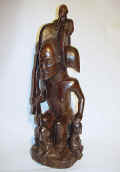 Maternity figure. Mother-and-child figures are relatively rare in Chokwe art. This finely carved example celebrates the image of a fulfilled woman proudly sitting with her children, and stresses the essential role of women as the providers of life who thereby ensure the community’s continuity and prosperity. The coiffure and the staff she holds underline her high status. The male ansestor figure atop her head speaks to her connection to the male Chokwe lineage. Material: wood |
Chief’s throne. An important chiefly accoutrement among the Chokwe was a throne which emphasized concepts of status, wealth, power, and accomplishment. During the seventeenth century, many Chokwe chiefs were introduced to chairs by Portuguese officials, and they adopted the foreign style for their thrones. The backrest and sitting of this throne are decorated with a face representing the Chokwe chief. The rungs are decorated with some figurative scenes. Material: wood, metal |
Pwo mask. The pwo mask represents a female ancestor who had died young and symbolizes the eminent position of the woman in the Chokwe matrilinear society. The mask evokes the female ancestor who exercises a favorable influence on the fecundity of her descendants. Pwo is the idealized image of the woman, source of life. The wearer, clothed “coquette”, performs an elegant dance for the assembled public. The dancers go from village to village and are recompensed for the favorable influence that their performances bring. Women also take part in the spectacle, but must keep their distance. In no case may they touch the wearer; this is a sacrilege punishable by malediction. Material: wood |
Size: 32" x 10" x 8" |
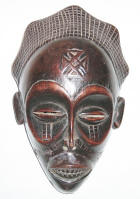 Pwo Mask Recently pwo has become known as mwana pwo, a young woman who undergone initiation and is ready for marriage. In terms of dance masks, the pwo is the incarnation of the female ancestor who encourages fertility; it is worn by a man dressed in a net tunic. It brings fecundity to the spectators, and it sometimes dances with a statuette that represents a mother carrying her child on her back. Among the mask’s typically Chokwe stylistic features are the slit eyes carved within sunken orbits, filed teeth, and facial scarifications that indicate the maturity of the female ancestor and visibly denote Chokwe identity.
THIS ITEM IS SOLD (NEVADA)
Material: Wood
|
|
|
KISI (or KISSI) Guinea and Sierra Leone The Kissi number 140,000 and inhabit a bordering region of Guinea and Sierra Leone. Essentially farmers, their daily life is organized around the cultivation of rice, in addition to manioc and cotton. Villages of about 150 people are situated in clearings. The Kissi revere soapstone (steatite) anthropomorphic carvings, which are found in fields and rivers in the area centered around Sewa and Mano rivers. The Kissi people call them pomdo (pombo), which mean "the deceased". Some of these carvings are extremely old. These statues were the abodes of the spirits of their ancestors. In order to find out which ancestor a statue represented, a man’s dreams were analyzed with the help of the diviner. At festivities the statue was wrapped in cotton upon which sacrificial blood had been poured. The owner (the guardian of the statue) placed it on the family altar; hence it was thought to be the family’s protector against sickness. It was also consulted before a new undertaking was planned. The statues were believed to have supernatural power and were used in rice cultivation. Remarkably, the descendants of the Kissi people still keep up the tradition of stone carving. |
|||||
|
8" x 4" x 2" |
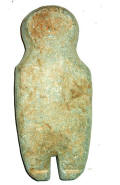 |
||||
|
Kom
|
|||||
|
Female Ferish This figure possibly presents a female ancestor. It has a square opening in its back and a hollowed out space that possibly held ceremonial objects or bones. Material: wood, rope, pigments, animal tooth Size: 21" x 8" x 11" |
|||||
KONGO
(BAKONGO, BASHIKONGO, KAKONGO)
The Kongo may number about three million people. Present in three countries – the Democratic Republic of the Congo, Angola and the Congo Republic – the Kongo occupy the region at the mouth of the Congo River. Numerous subgroups go to form the vast Kongo cultural complex, among which are the Vili, the Woyo and the Yombe. These tribes produce a diversity of artistic styles, with Kongo art being one of the best known. The Kongo demonstrate the extreme complexity of their traditions on major occasions, such as the investiture of a chief or at funerals. The Kongo pantheon was small: one all-powerful god who gave healing powers to the king, to the nganga, and to the heads of cults. Besides their textiles of great renown, the Kongo had a funerary art of decorated steles and funerary statues in stone, very often depicting the chief seated cross-legged in a posture of reflection. Some of these statues were placed on tombs to aid the spirits of the dead to join the world of the deceased. Wood sculptures represent royal wives, hunters, musicians, and healers. Their postures vary: sometimes they kneel in a position of respect, the head bent slightly backwards; women might be depicted seated with the child they hold by the neck or whom they are nursing. The cheeks are round, the face, carefully rendered, is realistic. The patina is smooth, the bust scarified. Elaborate geometrical patterns occur on the pedestal or the body, where they may be mingled with fine scarification marks. The figures were used to ward off danger to mothers during delivery and to protect the health of the child. The commemorative statues known as phemba were designed for women who had lost a child and wanted another. These carvings, generally sophisticated and very graceful, were thought to favor such a happy event. A maternity statue’s effectiveness depended on the dignity of the figure and its youth (shown by the firmness of the breasts) and the jewelry, which augmented its beauty and status. Although the majority of carved figures are made of wood, many important pieces in metal and ivory have been found. Among them are numerous metal figures clearly influenced by the Portuguese missionaries -- statuettes of Christian saints, for example. In addition to the figures, crucifixes were also produced, in brass or bronze (using the lost-wax method of casting). Nail and mirror fetishes are a unique and important phenomenon of Kongo sculpture. In the Kongo, all these fetishes are called nkisi. Nkisi means “medicine”. Historically, there were two types of nkisi, public and private, with some having vital democratizing roles, as sources of empowerment for rural residents and individuals outside the court. At most basic, the nkisi represents a container of empowering materials or “medicines” called bilongo. The magical substances may be blood along with animal, vegetable, and mineral matter. They are believed to invest the fetish figure with power and make it possible for the devotee to establish contact with the spirit. The “medicines” are generally secured in cavities in the stomach, head, or back to activate the work with the empowering agent. The nkisi, properly endowed with magic substances and additions by the nganga or doctor, had the power to act in a number of ways. There are four main types of nkisi, used for different purposes. Nkondi are fetishes of ill omen, usually brandishing a spear or a knife, while npezo are just as evil, but less menacing in attitude. Na moganga are benevolent figures, which protect against sickness and dangerous spirits. They help the hunter and the warrior; while mbula protect against witchcraft. All nkisi can be used for a variety of purposes and their meaning is ambivalent. The fetishes also may represent animals: two-headed dog, sometimes monkey. Masks are rare. There were worn during initiation ceremonies and the funerals of important personalities, but also appeared |
|||||
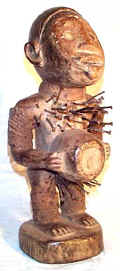
Nkisi – private nail fetish.
The nkisi is a spirit from the world of the dead. By extension, it is
the name given to the sculptures anticipated for use by man to gain hold of
a spirit from the beyond, then employing it for terrestrial aims.
Historically, there were two types of nkisi, public and private, with
some having vital democratizing roles, as sources of empowerment for rural
residents and individuals outside the court. In order to face certain trials
(illness, conflict, sterility, sorcery, etc), the Kongo take recourse in
this type of object. Thus they attempt to resolve their problem, or to
intimidate or punish the individual responsible for it. As one source says,
the nkisi is “a hiding place for people’s souls, to keep and compose
in order.”
The body of the fetish is covered by nails driven into its surface; these
objects mark each appeal made to the spirit embodied in it.
|
Maternity figure. Kongo artists carved numerous figures and objects characterized by naturalistic features. The figure of the mother and child is an icon of Kongo art. A maternity statue’s effectiveness depended on the dignity of the figure and its youth (shown by the firmness of the breasts) and the jewelry, which augmented its beauty and status. It is not a simple genre theme, but a statement of the spiritual power supporting society, the need for fertility and the promise of future generations. The founding-mother of the clan occupies a position of great respect; the Kongo art is one of the richest in representations of mother-and-child-group. The maternity statues were used to ward off danger to mothers during delivery and to protect the health of the child. Material: wood |
Female figure with child (pfemba). The figure of a mother and child is an icon of Kongo art. It is a statement of the spiritual power supporting society, the need for fertility. Mother and child sculptures generally represent women who are either nursing or holding a child, themes linked to married women and their roles in assuring continuity in the lineage. These figures possibly are connected with pfemba, a woman’s cult concerned with fertility and treatment of infertility. Material: wood Size: 19" x 6" x 5" |
Pfemba commemorative statue. Pfemba is a women’s cult said to have founded by a famous midwife, and concerned with fertility and the treatment of infertility. Commemorative pfemba statues, such as this one, were designed for women who had lost a child and wanted another. These sophisticated and graceful carvings were thought to favor a happy event. The present statue shows a woman kneeling with two children figures and a snake. Material: wood. Size: 25" x 8" x 8" |
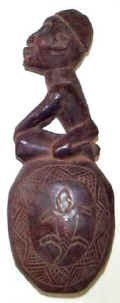 Musical instrument. The Kongo people number about three million. They occupy the region at the mouth of the Zaire River. Numerous subgroups go to form the vast Kongo cultural complex, among which the Vili, the Woyo and the Yombe are the best known. These tribes produce a diversity of artistic styles, with Kongo art being one of the best known. The human figure is used by the peoples of the Lower Congo in the decoration of almost every work -- from ceremonial objects and domestic utensils to pieces of furniture and architectural ornament. This musical instrument while being shaking produces rhythmic sounds what is an important element of music accompanying dances. On both sides of the musical instrument the images of a lizard, which is a hero of mythological origin, are carved. Material: wood Size: 12" x 5" x 2" |
|
|
Power figure: nkisi. The nkisi (pl. minkisi ) is a spirit from the world of the dead. By extension, it is the name given to the sculpted receptacles anticipated for use by man to gain hold of the spirit from the beyond, then employing it for terrestrial aims. The nkisi statues were designed for the individual or the family. They were consecrated by the fetishist. They have a reservoir at the stomach, which is intended for “medicines” and magic substances placed there by the fetishist. These may be white clay from the marshes, red clay used for ancestor worship, tukula (sawdust from red wood) sand, roots or leaves, or other objects. The nkisi were supposed to protect their owner’s health and transmit to him the vital strength with which they were endowed. The owner could give them offerings to escape from difficult situations. Material: wood, vegetable fiber,
feathers
|
Nkondi – private nail fetish. The nkondi is a particular type of nkisi. It is a spirit from the world of the dead. By extension, it is the name given to the sculptures anticipated for use by man to gain hold of a spirit from the beyond, then employing it for terrestrial aims. Historically, there were two types of nkondi, public and private, with some having vital democratizing roles, as sources of empowerment for rural residents and individuals outside the court. An nkondi is made by a sculptor who works together with a nganga (ritualist). The sculptor carves a male figure. Next, the nganga completes the figure by placing the ingredients that have positive or negative power in an abdominal cavity made by the sculptor. In order to face certain trials (illness, conflict, sterility, sorcery, etc), the Kongo take recourse in this type of object. Thus they attempt to resolve their problem, or to intimidate or punish the individual responsible for it. The body of the fetish is covered by nails driven into its surface; these objects mark each appeal made to the spirit embodied in it. Material: wood, nailsSize: 27" x 11" x 11" |
Ceremonial female figure. The Kongo demonstrate the extreme complexity of traditions on major occasions. Kongo artists carved numerous figures and objects characterized by naturalistic features. This sculpture includes the royal cap, leopard-claw necklace. This figure may be a wife of the king or ir is related to pfemba, a woman’s cult concerned with fertility and treatment of infertility
Material: Wood
|
|||
KORO (KWARO) Nigeria The Koro people settled in Nigeria, north of the junction of the Niger and Benue Rivers. They carve abstract headdresses embellished with red seeds, which are thought to symbolize ancestor spirits and are used during agricultural rites and important social or family events. The Koro also sculpt cups for beer and palm wine that are used in sacrificial offerings and in second funerals (those that, after a certain period of burial, celebrate the arrival of the dead in the afterlife). In anthropomorphic versions, the containers correspond to the stomach of the feminine figure. The curvilinear form shrinks in the center, recalling the shape of pumpkins, commonly used as containers for liquids. |
|||||
Possible Yaka 13" x 4" x 3" |
Ceremonial Cup for Beer and Palm Wine. The Koro people settled in Nigeria, north of the junction of the Niger and Benue Rivers. They carve cups for beer and palm wine that are used in sacrificial offerings and in second funerals (those that, after a certain period of burial, celebrate the arrival of the dead in the afterlife). In anthropomorphic versions, the containers correspond to the stomach of the feminine figure. The curvilinear form shrinks in the center, recalling the shape of pumpkins, commonly used as containers for liquids. Material:
wood |
||||
KOTA and MAHONGWE (AKOTA, BAKOTA, KUTA) Gabon and People's Republic of the Congo The land of the Kota, numbering some 75,000, is situated in the eastern part of Gabon, extending slightly into the People’s Republic of the Congo. The Kota are actually a number of groups of peoples with common cultural traits. Although these peoples share many cultural traits, they are by no means homogeneous. The rain forests which surround the Kota are farmed with slash and burn techniques, combined with crop rotation. By moving crops from year to year, erosion and soil depletion is avoided. The main crops grown are plantains and manioc. The Kota live in villages comprising two or more clans. Clans in turn comprise several lineages or family groups that trace their descent from a common lineage ancestor. This is an important point related to their art, for like the Fang, the Kota revere the relics of ancestors. Ancestor worship formed the core of the family group’s religious and social life. At the death of a chief, the initiates would take from the body of the deceased various relics, which were then decorated with metal and rubbed with powders of multiple magical powers. The Kota have produced large quantity of statues of ancestors with the diamond-shaped lower part called mbulu-ngulu; these rather two-dimensional sculptures are in wood; symbolic metals were applied to the upper part in strips or sheets to add power. Copper in particular was identified with longevity and power. These statues stood guard in cylindrical bark boxes, on baskets or bundles called bwete that contained the skulls and bones of important ancestors. Bound into a packet and lashed to the base of a carved figure, the bones formed a stable base that allowed the image to stand more or less upright. Thanks to the diversity of the groups, scattered over a vast area, a great variety of different styles of figures has developed, some of them endogenous and some influenced by neighboring styles. Kota figures represent an extremely stylized human body, reduced to shoulders and “arms,” in emptied lozenge shape, surmounted by a large face framed by an ample coiffure with hanging tresses. The face, always oval, may be concave (female), convex (male) or concave-convex, with a forehead in quarter-sphere (also male). The reliquaries were kept outside the homes, in huts at the edge of the village. Only the initiates of the lineage had access to this sacred place. At the time of initiation in the reliquary cult, the clans would meet to perform communal rituals; each clan’s chief would dance holding the reliquary. Some reliquaries featured a large figure representing the lineage founder along with some smaller figures representing his successors. There are figures with two identical or different faces made on two opposite sides of the flat head.
The bwete was called on in time of crisis to combat unseen agents of harm. Its intercession was sought in such vital matters as fertility, success in hunting, and in commercial ventures. A husband could use it to guard against his wife’s infidelity, for it was believed that if he placed pieces of her clothing in the reliquary, an unfaithful wife would be driven mad. Families took their bwete to ceremonies of neighboring villages to strengthen the allied community. The display of the bundles and their shiny, visually riveting figures was accompanied by feasting, dancing, and the making of protective medicines. These bwete were kept for generations, but during the 20th century, when religious beliefs changed, they were abandoned or even destroyed.
The Kota helmet masks known as emboli or mbuto measure between 40 and 80 cm. In Kota villages the masks are worn during dances in celebration of the initiation of adolescent boys. During the ‘pedagogical’ part of the ritual the elders demonstrate to the young men that the masks are not monsters but human beings like themselves. The mask is also worn during anti-sorcery séances or for psychotherapeutic purposes. The mask representing a human head with a crest similar to the sagittal crest of the gorilla, covers the dancer’s face completely and is supported by a basketwork frame.
MAHONGWE (HONGWE, HUNGWE, MAHONGOUE, MAHOUNGOUE, OSSYEBA)Gabon The Mahongwe constitute the northern branch of the Kota peoples. They live in the extreme northeast of Gabon near the Republic of the Congo border. Numbering between 3,000 and 5,000 individuals, they have long remained apart owing to their obstinate resistance to the penetration of French administration. The Mahongwe practice an ancestor cult (bwiti or bwete) that was at the center of a system of beliefs and rites and ancestor worship formed the core of the family group’s religious and social life. Fearful of the deceased the Mahongwe showed particular devotion to relics of important ancestors of the lineage, guarantors for the protection and survival of the group. At the death of a chief, the initiates would take from the body of the deceased various relics, which then decorated with metal and rubbed with powders of multiple magical powers. These relics, augmented by some “charms” and other power substances, were kept in woven rattan baskets upon which were arranged reliquary figures in wood plated with thin copper or brass strips, plates of wire. It was believed that the sculls and bones of important men retained their power after death. Every Mahongwe clan has a reliquary kept in the back of the chief’s hut. These relics were expected to protect and benefit the families that owned them. At the time of initiation in the reliquary cult, the clans would meet to perform communal rituals; each clan’s chief would dance holding the reliquary. Some reliquaries featured a large figure representing the lineage founder along with some smaller figures representing his successors. Mahongwe reliquary figures consist of three distinct sections: the oval, concave face with projecting top knot, the cylindrical neck, and an openwork base. The mouth is missing. The heads of these remarkable abstractions are large and do not have upper or side pieces. The base is of lozenge form. They are considered dangerous to handle because of their role in former funeral rites, which have not been practiced for over sixty years. Mahongwe masks are rare. |
|||||
Mahongwe (Hongwe, Hungwe, Mahoungoue, Ossayeba), Gabon and Congo RepublicReliquary figure. Mahongwe are in the extreme northeast of Gabon near the Congo border. These populations have links with the Kota and are themselves divided into subgroups. Ancestor worship formed the core of the family group’s religious and social life. At the death of a chief, the initiates would take from the body of the deceased various relics, which then decorated with metal and rubbed with powders of multiple magical powers. They would be kept in baskets surmounted by reliquary figures. Although recognizably human because of its eyes and nose, the ancestor’s face is severely formalistic. The Mahongwe covered these figurines with copper or brass. At the time of initiation in the ancestor cult, called the bwete, the clans would meet to perform communal rituals; each clan’s chief would dance holding the reliquary. Material: wood, brass or copper
sheeting and vegetable fiber |
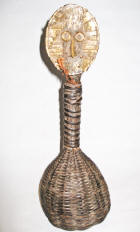 14" x 5" x 5" |
Kota (Akota, Bakota, Kuta), Gabon and Republic of Congo Reliquary bwete figure. Several ethnic groups termed “Kota” use this kind of abstract figures as guardians for ancestral bone relics kept wrapped in baskets or bark boxes. Historically, the Kota left their dead unburied in the forest far from the village. Under the influence of neighboring tribes, they then began to bury their dead. Chiefs were always buried, but often their bones (especially the skull) were later exhumed and placed with magical objects (shells, seeds, fruits) in a dark box or a basket called a bwete, in which a carved figure was placed. These figures are unusual in African representation of the human head because of their flat, two-dimensional character. The head rests on a column, which opens to lozenge shaped arms. These are set into the basket that contains the precious relics, bones of the ancestors. Kota rituals allied to ancestor cults aimed to honor illustrious deceased members of the lineage, but also would carefully keep them out of reach of other villagers. Terms such as abstraction or realism are inappropriate here, for this is an example of the most extreme stylization. Apparently this bwete was intended to serve for this purpose.
Material: wood, raffia, metal sheeting, feathers |
|||
KUBA (BACOUBA, BAKUBA, BUSHONGO) Democratic Republic of the Congo Numbering about 250,000 the Kuba live in the area of central DRC bordered by the Sankuru, Kasai, and Lulua rivers. This is a region of valleys where numerous rivers flow south to north; the hills are covered with brush and the rivers are bordered by forests. Farming, aside from clearing the fields, was women’s work; they cultivate manioc, corn, gourds, bananas, pineapples, and palms. Tobacco was grown by the men. The hunt, a collective enterprise using nets, brought prestige and reinforced the social cohesion between the villagers. To fish the rivers required the participation of the entire village in order to build canoes. Although today most Kuba ethnic groups are organized into independent chiefdoms, they still recognize the authority of the Bushong king. The art of the Kuba is one of the most highly developed of all African traditions, and significant cultural accomplishments are part of their heritage. Among the best known of Kuba art forms are royal portrait figures, ndop, idealized representations. An ndop may have played a role in the installation of the king, and during his life it is said to have been not only a portrait but also the soul double of the king. Whatever happened to him was believed to happen to it as well. Closely associated with the king’s fertility, the ndop was kept in the woman’s quarters, and was placed next to his wives during childbirth to ensure safe delivery. The kings typically sit facing forward with legs crossed, the left in front of the right; the right hand, with fingers extended, rests on the right knee, and the left hand holds the royal dagger. Geometric patterns cover the stomach and are continued on the back of the figure. The royal statues show the king wearing a rectangular shody hat; they are mounted on quadrangular pedestals. The sculptures include objects significant to each particular king, identifying his own personal accomplishments. Developing from the court style was a popular style, which utilized geometric forms instead of the well-modeled, full-volume forms of the court figures. Kuba fetishes, emphasizing only essential organs, are highly schematic. The popular style can also be found in the utensils and textiles produced by the Kuba. Over twenty types of masks are used among the Kuba, with meanings and functions that vary from group to group. Kuba wooden helmet masks are probably the most commonly produced items, popular with the collectors. These striking masks are wonderfully decorated with geometrical surface designs in dazzling contrasts of color, pattern, and texture. Hide, animal hair, fur, beads, cowrie shells, and feathers ornament the masks, and costumes of bark-cloth, raffia fiber fabric, and beaded elements complete the manifestation of nature spirits, intermediaries between the Supreme Being and the people. One widespread context for masking is initiation. Every several years a group of boys will be inducted into manhood through the initiation which transforms uncircumcised boys into initiated men who possess esoteric knowledge. Funerals are a second important context for masks throughout the Kuba area. Three types of masks have been associated with dances that take place within the royal compound: the first, called Moshambwooy, represents Woot, the founder of the Bushoong, the culture hero. The second, known as Nady Amwaash (Ngaady A Mwash), personifies the wife/sister of Woot, a character said to have been introduced to the pageantry to give greater importance to the role of women. The third mask is called Bwoom. As a character, Bwoom has been interpreted variously as a prince (the king’s younger brother), a commoner, a pygmy, even a subversive element at the royal court. There are many differences among regional stylistic interpretations of the Bwoom mask, but the form’s most pronounced features invariably are its bulging forehead and broad nose. The drama is often reenacted in performances at public ceremonies, initiations, and funerals even of untitled men, though they are especially important at the funerals of titleholders. Bwoom is perhaps the oldest of the Kuba royal masquerade triumvirate. Oral traditions suggest that the genre may date back to about the middle of the eighteenth century. Other masks are collectively known as Isheene Mwalu. The Kuba love of form, knowledge of materials, skill in execution, and appreciation of quality are best seen in the number and variety of cups and goblets, mostly for drinking palm wine. There are reports – not confirmed – that these cups might have been used in the poison ordeal. Among the Kuba, as among other African tribes, death was never attributed to natural causes but to malevolent spirits or to witchcraft. The person suspected of using witchcraft was required to drink poison from such a cup. If he vomited up the drink, he was declared innocent. On the other hand, his death proclaimed his guilt and constituted his punishment. The Kuba smiths worked with copper, iron, and brass, making weapons and tools to be admired as well as used. In some cases, one metal was inlaid with another. The Kuba also give expression to their great artistic sense in utensils: boxes, weapons, tobacco pipes, drums, drinking horns, bells, well-known musical instrument sanza, and textiles with ingeniously designed pattern work. The luxury articles made for the court are characterized by elaborate execution and rhythmically balanced form; for it was at court that the finest artists gathered, and here that they had an opportunity to gain prestige and renown. A good carver had the rank of a senior official. |
|||||
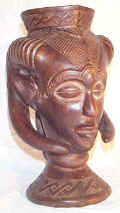 Mbwoong ntey palm wine cup. The Kuba excelled in making objects of prestige for the dignitaries of the court. Some of the most spectacular Kuba prestige objects are cups for palm wine. They customarily decorate prestigious drinking cups with figural designs. The Kuba love of form, knowledge of materials, skill in execution, and appreciation of quality are best seen in the number and variety of cups and goblets, mostly for drinking palm wine. The ram horns sprouting from the head indicate that the cup belonged to a senior title-holder, again a reference to the royal prerogative of keeping sheep, which was occasionally extended to some members of the royal clan. Material: wood Size: 13" x 8" x 8" |
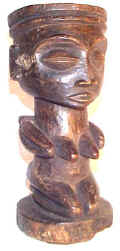 Mbwoong ntey ceremonial cup.The Kuba customarily decorate drinking cups with chip-carved geometrical designs. However, cups intended for use by rulers are elaborately decorated. This one is carved in the form of a kneeled deformed female figure. Usually during certain ceremonies and rituals kings were served palm wine in richly decorated cups. A servant took the first sip, and than presented the cup to the king. There are also reports that these cups might have been used in the poison ordeal. The person suspected of using witchcraft was required to drink poison from such a cup. If he vomited up the drink, he was declared innocent. On the other hand, his death proclaimed his guilt and constituted his punishment. Such cups, highly prestigious possessions of Kuba men in 19th and 20th centuries, have been gradually supplanted by metal or plastic vessels. Material: wood |
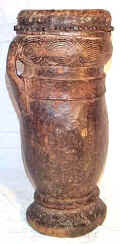 Ceremonial drum. Today the Kuba form a confederation of nineteen ethnic groups dominated by the Bushoong. Each clan pays tribute to the king of the Bushoong ruling clan, but their internal affairs are dealt with autonomously. The rivers which define the Kuba territory provide the fish consumed in the area. They cultivate manioc, corn, gourds, bananas, pineapples, cassava, and tobacco. The Kuba weave beautiful raffia cloth, which is embroidered by the women and traded to surrounding areas. The art of the Kuba is one of the most highly developed of all African traditions, and significant cultural accomplishments are part of their heritage. The drum is an indispensable musical instrument for different ceremonies of the Kuba people. This drum is a good example of ceremonial drums.
Material: wood, leather |
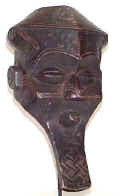 Isheene Mwalu ceremonial mask. Kuba wooden masks are probably the most popular with the collectors. Over twenty types of masks are used among the Kuba, with meanings and functions that vary from group to group. One widespread context for masking is initiation. Every several years a group of boys will be inducted into manhood through the initiation, which transforms uncircumcised boys into initiated men who possess esoteric knowledge. Funerals are a second important context for masks throughout the Kuba area. A hierarchy of masks appears at funerals even of untitled men, though they are especially important at the funerals of titleholders. All the masks besides tree royal masks are collectively known as Isheene Mwalu. The specific function of this mask is unknown. Material: wood Size: 18" x 12" x 11" |
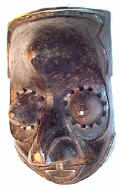 Pwoom itok dance mask. The Kuba, numbering 250,000, cultivate manioc, corn, gourds, bananas, pineapples, and tobacco. The creator god is not formally worshiped. At one time the Kuba had a religion based on ancestor worship, but this seems to have died out, although divination is still practiced in order to discover causes of evil. The Kuba, a confederation of nineteen ethnic groups dominating by the Bushong, have over twenty different mask types considered embodiments of spirit. In addition to the three royal masks, there are other dance masks, of which the main one is the pwoom itok presented here. Its primary characteristic is the shape of the eyes, whose centers are expressed as cones surrounded by small cones. Sub-styles have multiplied the variations of this mask. Material: wood |
|
|
Material: wood Size: 11" x 4" x 4" |
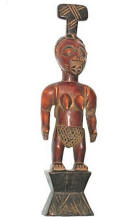 15" x 4" x 3" |
Oracle. The high quality of Kuba art is found at every level of society, in secular and utilitarian objects as well as those serving ritual and prestige purposes. Oracles, usually in the form of an animal symbolically associated with spirits and clairvoyance, are used by diviners. A kind of knob is rubbed along the figure’s back; where it stops determines the interpretation of the oracle’s message. Material: wood Size: 16" x 2.5" x 2" |
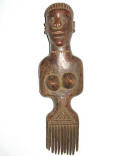 Comb. Elaborately carved and decorated combs in a rich array of forms are worn as hair ornaments in particular areas of West and Central Africa including the Kuba Cultural Region. Material: wood Size: 10" x 3" x 2" |
Ceremonial Drum Materials: wood, animal hides, pigments Size: 31" x 10" x 9" |
|
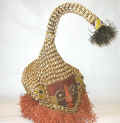 Mashamboy (Woot) helmet mask. The Kuba, a confederation of nineteen ethnic groups dominated by the Bushong, have over twenty mask types considered embodiments of spirits. This mask is one of three most significant types belonging to the royal family. According to a source, this mask was invented around 1350 A. D. Mythical origins and royal power struggles are reenacted ritually with the triad of masks during important initiation and funeral ceremonies. A mask representing both the god Woot and a king Mashamboy falls in love with his sister Mgaady A Mwaash, who becomes his wife. His brother, Bwoom, contests Mashamboy’s right both to the throne and to Mgaady. The superstructure of the mask represents the trunk of an elephant, which is a royal emblem. The masqueraders invoke the Bushong myth of creation and also historical events. It also served to enforce the law. Material: textile, beads, cowries, raffia, wood, vegetable fiber Size: 22" x 13" x 14" + raffia |
Bwoom helmet crest.* CLICK ON PHOTO _ NO LINK! One of the three royal masks, the Bwoom is one of the oldest mask types used by the Kuba. It is said to have been introduced in the seventeenth century. The masqueraders appear on numerous ceremonial occasions, embodying different characters depending on the context. At boys’ initiations, Bwoom represents the nature spirit Ngeesh. As part of the royal mask trio, he personifies an opposition, recalcitrant character who struggles with his brother Woot for power and for possession of his wife and sister, Ngaady a Mwaash. In his role as an insurgent who challenges the throne and its system, Bwoom is moreover associated with non-aristocratic, common man. The rebellious aspect of the Bwoom masquerader is expressed in a proud and aggressive style of dancing. According to one of the various legends surrounding the origin of the Bwoom, the bulging forehead and form of the mask imitate the heads of pigmies. Material: wood, metal sheeting, textile, cowries, glass beads Size: 21" x 13" x 8" |
Ceremonial container/vessel Material: wood 14" x 10" x 10" |
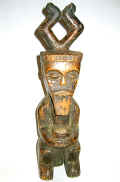 The meaning of this sculpture is a mystery.
Material: wood Size:
14" x 4" x 5" |
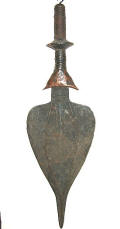 Sword. This is a short sword known as ikul. Ikul is perhaps the most commonly seen type of weapon among the Kuba, and it is said a true man is never without one. The most sumptuous ikul belong to the high nobility or the king himself, and their blades are inlaid with red or yellow brass. Material: iron, brass and wood Size: 18" x 6"
|
|
|
Material: iron and wood Size: 25" x 8" |
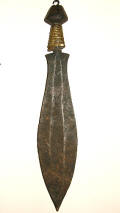 Sward. This is a short sward known as ikul. Ikul is perhaps the most commonly seen type of weapon among the Kuba, and it is said a true man is never without one. The most sumptuous ikul belong to the high nobility or the king himself, and their blades are inlaid with red or yellow brass. Material: iron, brass and wood |
Material: metal, wood Size: 16" x 8" |
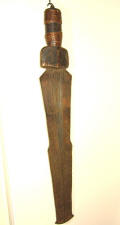 Material: metal, wood 18" x 3.5"
|
||
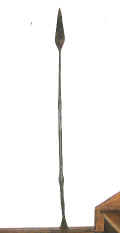 Spear. Numbering
about 250,000 the Kuba live in the area of central DRC bordered by the
Sankuru, Kasai, and Lulua rivers. This is a region of valleys where numerous
rivers flow south to north; the hills are covered with brush and the rivers
are bordered by forests. Farming, aside from clearing the fields, was
women’s work; they cultivate manioc, corn, gourds, bananas, pineapples, and
palms. Tobacco was grown by the men. The hunt, a collective enterprise using
spears and nets, brought prestige and reinforced the social cohesion between
the villagers. This spear came from the Kuba cultural region and was in
their possession.
Spear. Numbering
about 250,000 the Kuba live in the area of central DRC bordered by the
Sankuru, Kasai, and Lulua rivers. This is a region of valleys where numerous
rivers flow south to north; the hills are covered with brush and the rivers
are bordered by forests. Farming, aside from clearing the fields, was
women’s work; they cultivate manioc, corn, gourds, bananas, pineapples, and
palms. Tobacco was grown by the men. The hunt, a collective enterprise using
spears and nets, brought prestige and reinforced the social cohesion between
the villagers. This spear came from the Kuba cultural region and was in
their possession.Material: metal, wood Length: |
Material: metal, wood Length: |
||||
KURUMBA (FULSI, KORUMBA, KOUROUMBA) Burkina Faso The 200,000 Kurumba people live in the north of Burkina Faso. They live in extreme heat and cope with many diseases in addition to their dependence on a very short and unpredictable rainy season. They cultivate millet and cotton, and rear cattle in the savannah regions. The Kurumba produce a mask headdress in the form of antelope head. The approach is naturalistic, although there is some stylization. The powerful neck supports a head with a pointed protruding snout, and this line extends upwards, beyond the long sharp ears, in a gentle curve ending with the vigorous towering horns. These finely-shaped antelope heads are colorfully painted with large triangles in white, brownish-red, black, and light-blue, and sometimes the triangles are filled in with rows of spots. The headdress represents Yirige, the culture hero, who drove away evil spirits at the first tilling of the land. Mask dancers descended from heaven repeat the deeds of the hero-founder Yirige and his children. The mask also appears at the death ritual following the mourning period. The mask, which to an observer seems impossible for a dancer to balance, is fastened to the head with a plaited basket or by some other way. Other masks are rare. |
|||||
|
Material: wood Size: 63" x 21" x 11" |
|||||
|
KUSU (BAKUSU) Democratic Republic of the Congo About 60,000 Kusu live on the left bank of Lualaba River. During their exodus from north, they passed through Luba, Hemba and Songye lands where they assimilated social and artistic traditions of these ethnic groups. They are divided into clans, each headed by a chief Wembi, assisted by village chiefs, known as Mwamkana, and by family chiefs called Bankumi. Historically, the Kusu were hunters, but now they grow maize, yams, beans, and raise animals, including cows, pigs, goats, and chickens. Fishing is performed by both men and women. They recognize a supreme being (Vilie) and share a common belief in the power of the ancestors. They worship various nature spirits, recognize ancestor cults that have been borrowed from the Hemba and the Luba, and fashion and use powerful magical figures similar to those found among the Songye. There is an initiation society, which is primarily aimed at educating people about the evils of witchcraft, and there are also diviners that are consulted for matters of importance. Nothing precise is known about the Kusu art. It is relatively rare and is highly influenced by the neighboring Luba, Songye, and Hemba. Statues are usually carved from dark red wood sometimes covered with an oily patina. No Kusu masks have been identified so far. |
|||||
|
Material: wood Size: 12" x 4" x 4" |
This elaborate drum is supported by seated male and female ancestor figures who in turn are seated atop a lisard-like totemic beast. Material: wood, animal hide, nails Size: 45" x 15" x 14"
|
||||
KWELE (BAKWELE, BEKWIL, EBAA, KOUELE) Cameroon, Gabon, Republic of the Congo The Kwele occupy a great forest region on the borders of Gabon, Cameroon and the Republic of Congo. Their village communities comprised a number of lineages and were governed in the usual way for "headless" equatorial societies, that is in a diffuse and more or less informal manner. The Kwele believe that unexplained deaths, epidemic smallpox, and other mysterious threats to the well-being of individuals or the community are caused by witchcraft. Witches are believed to live in male or female hosts, from which they emerge at night to feed upon the internal organs of their victims. The antidote to witchcraft is the beete ritual, which includes masked performances. The beete cult reinforces unity and maintains social order. The ritual, which lasted for a week, would open with the departure of men into the forest to hunt antelope, whose flesh, seasoned with medicines, had to be eaten at a meal at the closing ceremony. During the hunt, women and children stayed in the village; after one or two days, ekuk masks would “leave” the forest, enter the village, and invite the people to come dance and sing. Ekuk means both “protective forest spirit” and “children of beete.” It displays a flat surface and often has a whitened heart-shaped face, a triangular nose, coffee-bean eyes and small or non-existent mouth. This mask, with two large horns, represents the antelope. The faces are usually painted in white kaolin earth, a pigment associated by the Kwele with light and clarity, the two essential factors in the fight against evil. Later another mask, the gon (gorilla), announced by bells, would make its entrance; the women would immediately lock up all the domestic animals inside the huts; everyone would begin looking for shelter. Gon is a dangerous mask. The wearer of the gon mask is nude – as opposed to the person dressed in the ekuk, who wears a wide skirt of fibers. The gon mask is made in the image of a skull of a gorilla, an animal feared by the Kwele because of its frequent destruction of their crops. The masks are hung in Kwele houses and also worn during dances related to initiation ceremonies of the beete cult. Their function was to "warm up" the village atmosphere in order to activate the beneficial forces. Maskers made the spirits manifest. Entering the village to the accompaniment of music, male spirits pranced rhythmically, while female spirits (also danced by men) shuffled slowly. Some other masks have obvious animal or bird attributes and bear their names; others are enigmatic in their identity. Stylized sculptures with similar facial features are also produced. Inside the Kwele huts sculpted plaques can be found. |
|||||
 Statue. The Kwele believe that unexplained deaths, epidemic smallpox, and other mysterious threats to the well-being of individuals or the community are caused by witchcraft. Witches are believed to live in male or female hosts, from which they emerge at night to feed upon the internal organs of their victims. The antidote to witchcraft is the beete ritual. The statues of this kind apparently take part of this ritual.
Material: wood, wicker |
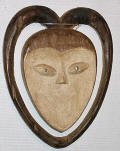 Size: 13" x 11" x 2" Size: 21" x 5" x 2" 9" x 7" x 1"
Material: wood
|
Mask Material: wood Size: 13" x 9" x 3" |
|||
|
Material: wood |
|||||
| Total items this section | 148 | ||||
